Huge congratulations to our newest teammates on reaching their first month! Your energy and contributions are already felt across the team. Drop some love and a quick note below ❤️🎉
#onboarding #first-monthRemote work has moved from a temporary solution to a new standard for modern organizations.
Teams now collaborate across continents, and the way a company welcomes new hires defines how people feel about joining and staying.
Remote employee onboarding is no longer a checklist.
It is the digital first impression of your culture.
When done right, it creates belonging, clarity, and motivation.
When done poorly, it leaves confusion and distance.
This guide walks you through every step of building a structured, human, and automated employee onboarding process for remote teams.
Why Remote Onboarding Matters More Than Ever
Remote work has evolved from a temporary solution into a permanent way of operating.
It opened doors to global talent, but it also revealed how fragile traditional onboarding can be when distance enters the equation.
When onboarding happens through screens instead of hallways, culture becomes something you must design, not something people absorb naturally.
The very first onboarding experience is no longer about showing the office; it is about showing who you are as a company.
The Evolution of Remote Work
A few years ago, onboarding meant sitting beside a colleague, meeting people at lunch, and walking through an office tour.
Now, that entire journey happens digitally.
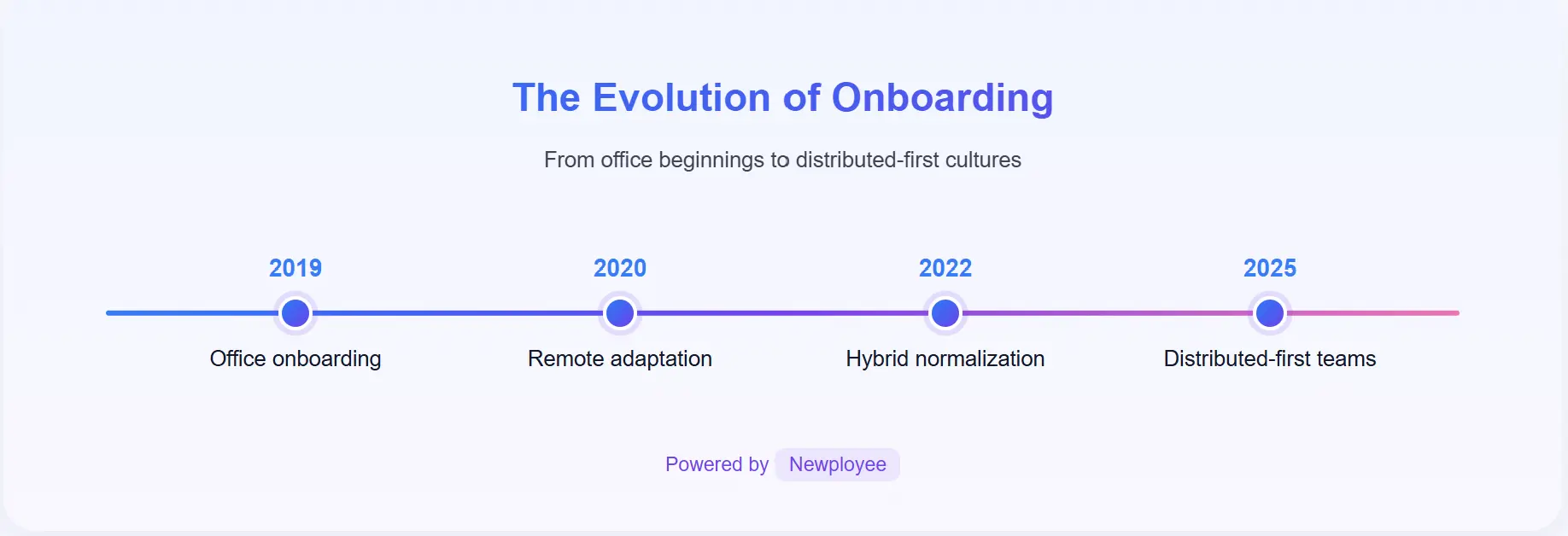
As teams became global, HR faced a new reality.
People join from different time zones, different cultures, and sometimes entirely different continents.
Without structure, new hires feel like they joined an empty space instead of a living team.
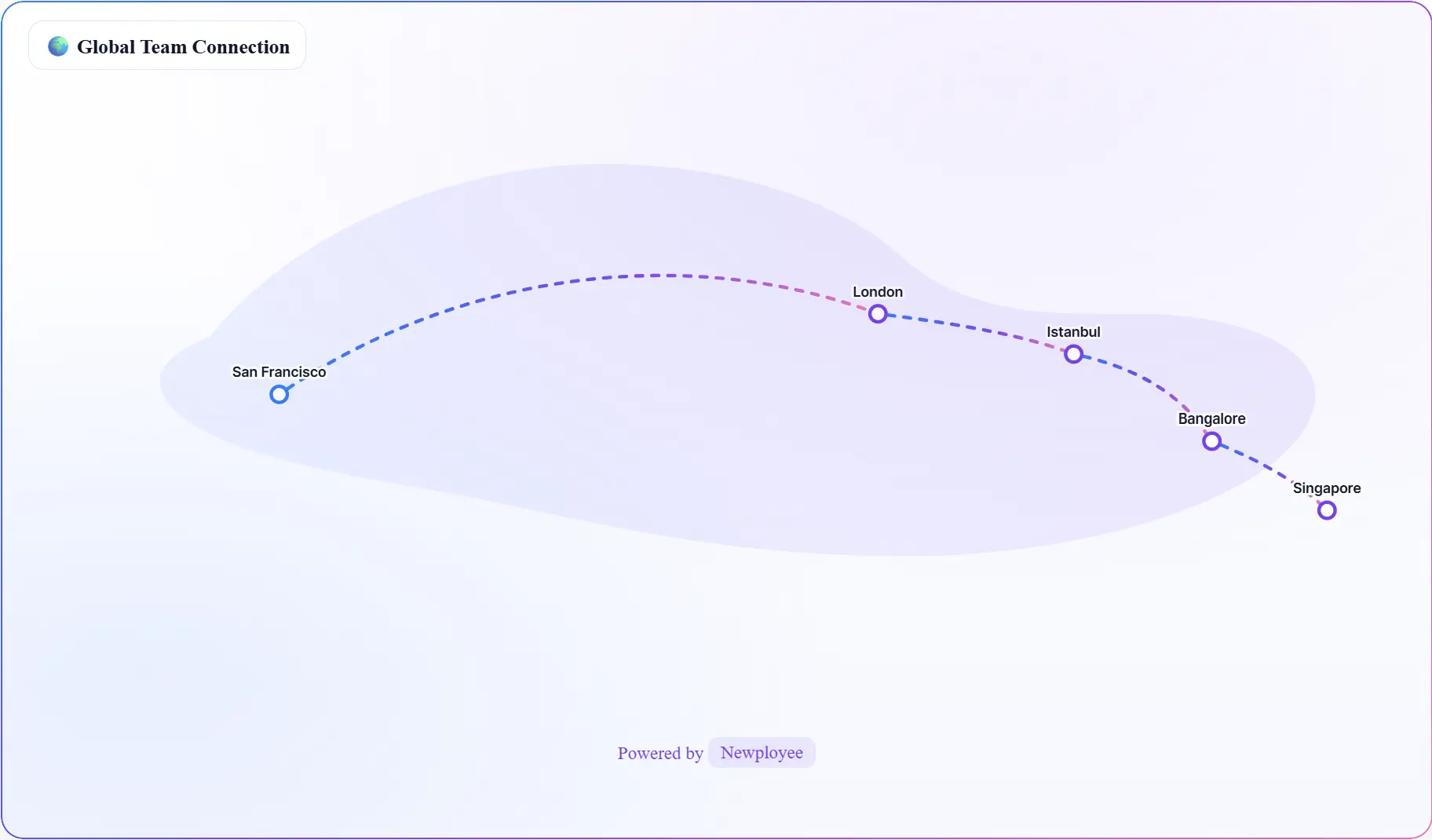
A strong onboarding process now acts as the digital handshake that brings everyone together.
The Hidden Cost of Poor Onboarding
When onboarding is unclear, confusion multiplies quietly.
No one intentionally decides to create a bad experience, it simply happens when there is no structure.
Emails are forgotten. Tools are not ready. The first day calendar is empty.
The result is silence, and silence feels like neglect.
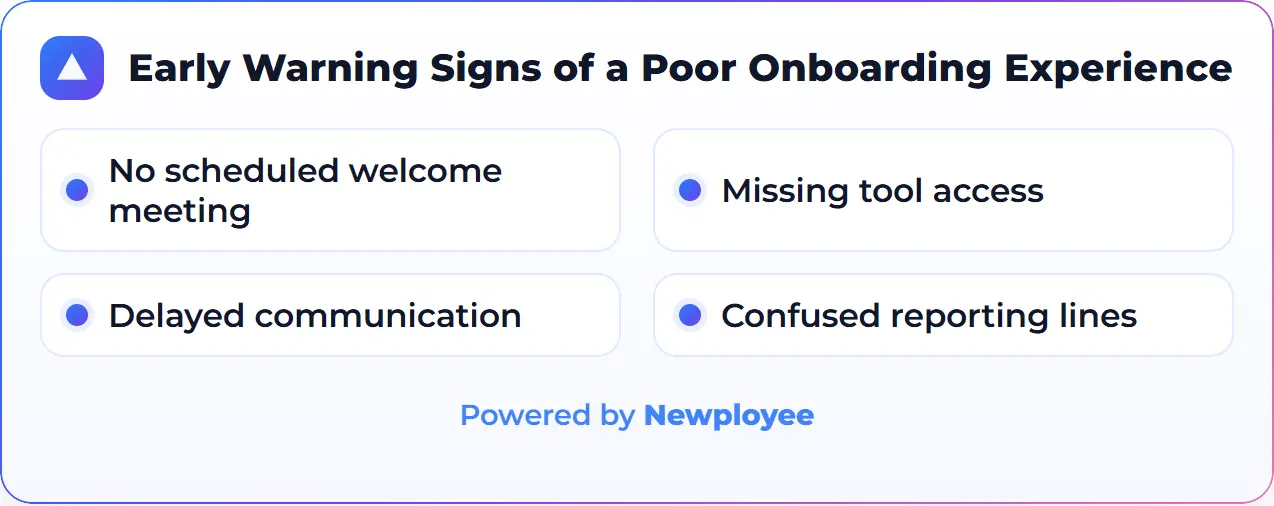
Once that trust is broken, it rarely returns easily.
A disorganized start affects morale, productivity, and even retention.
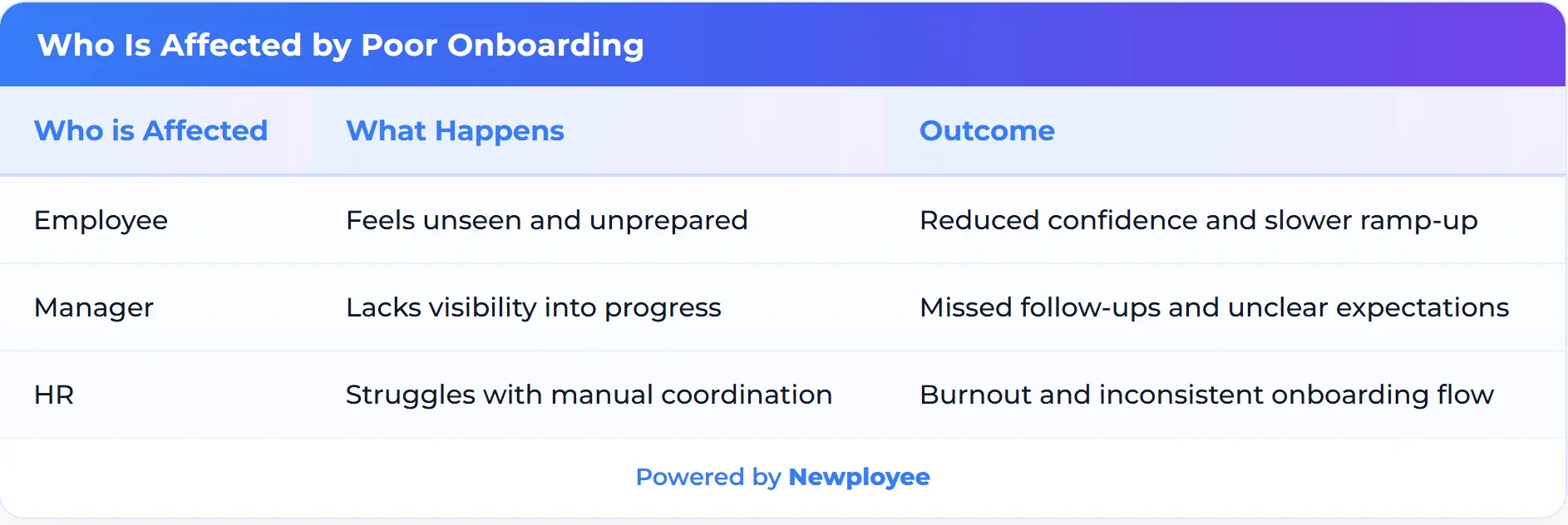
Beyond engagement, the financial side is equally serious.
Replacing one disengaged employee can cost more than half of their annual salary.
That cost begins long before resignation, it starts the moment a new hire feels disconnected.
The Cultural Importance of Belonging
Belonging is what transforms remote work from function into feeling.
When employees cannot walk into an office, they rely entirely on communication and clarity to know if they belong.
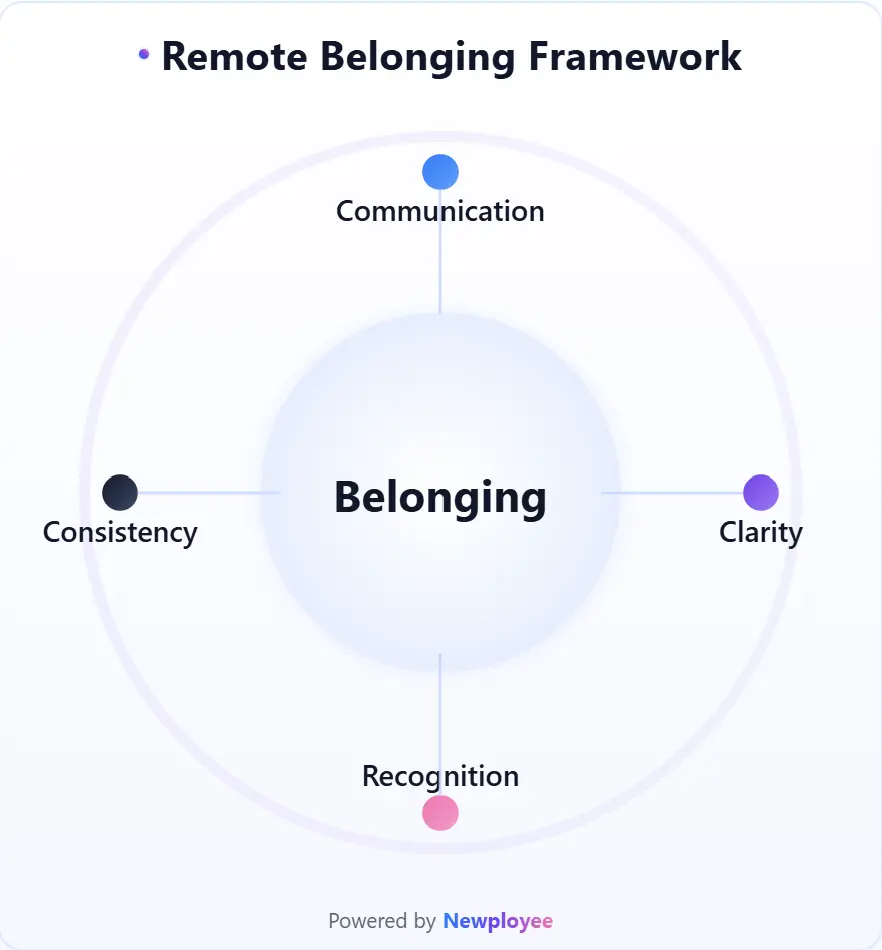
A short message from a manager, a virtual welcome call, or even a first-day emoji reaction builds connection faster than policies ever could.
It is the repetition of small gestures that creates a sense of community.
Without these moments, remote work becomes isolation disguised as flexibility.
Employees start to wonder if their presence matters.
When belonging is intentionally designed, it creates trust, stability, and long-term engagement.
The Business Case for Human Onboarding
Onboarding is not a soft skill activity; it is a performance driver.
Every hour of structure invested here saves weeks of confusion later.
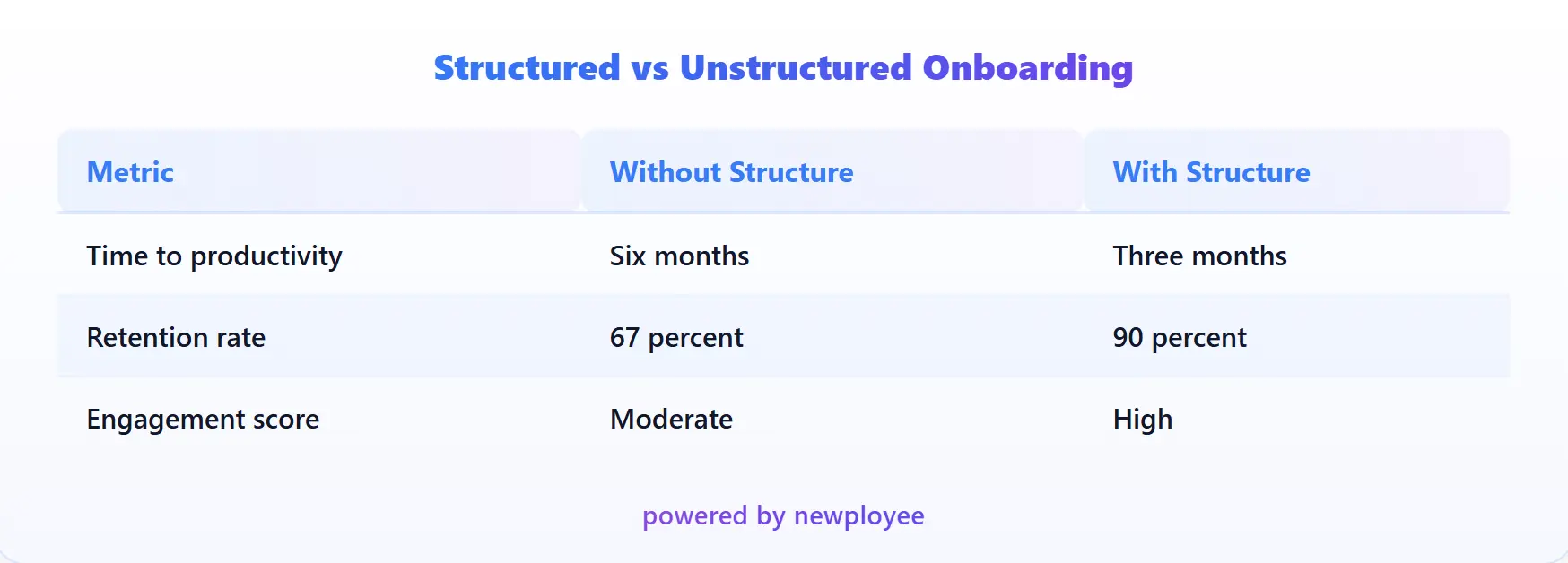
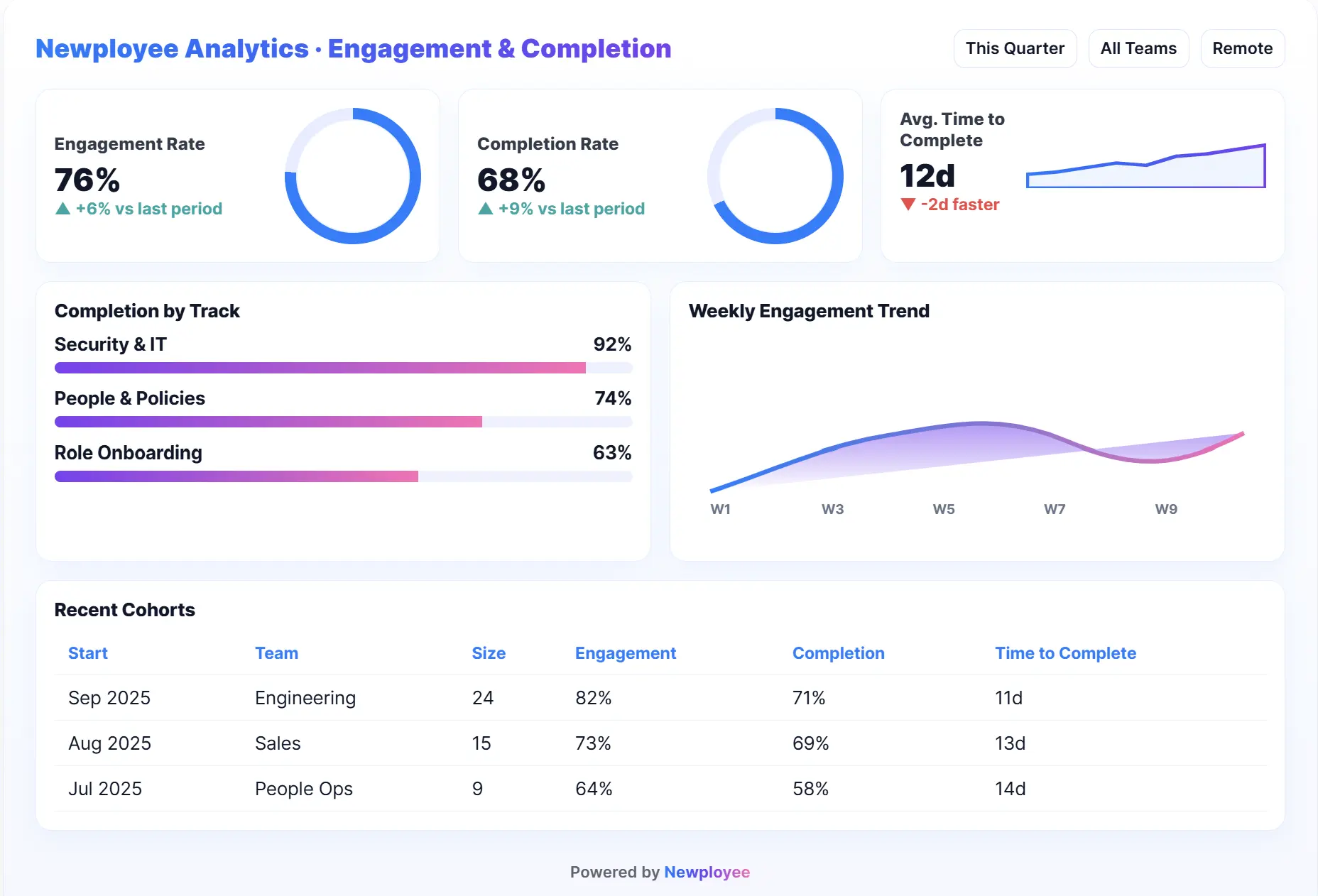
When onboarding is designed with both automation and empathy, employees feel supported while operations stay efficient.
It is not about choosing between human and digital, it is about letting each strengthen the other.
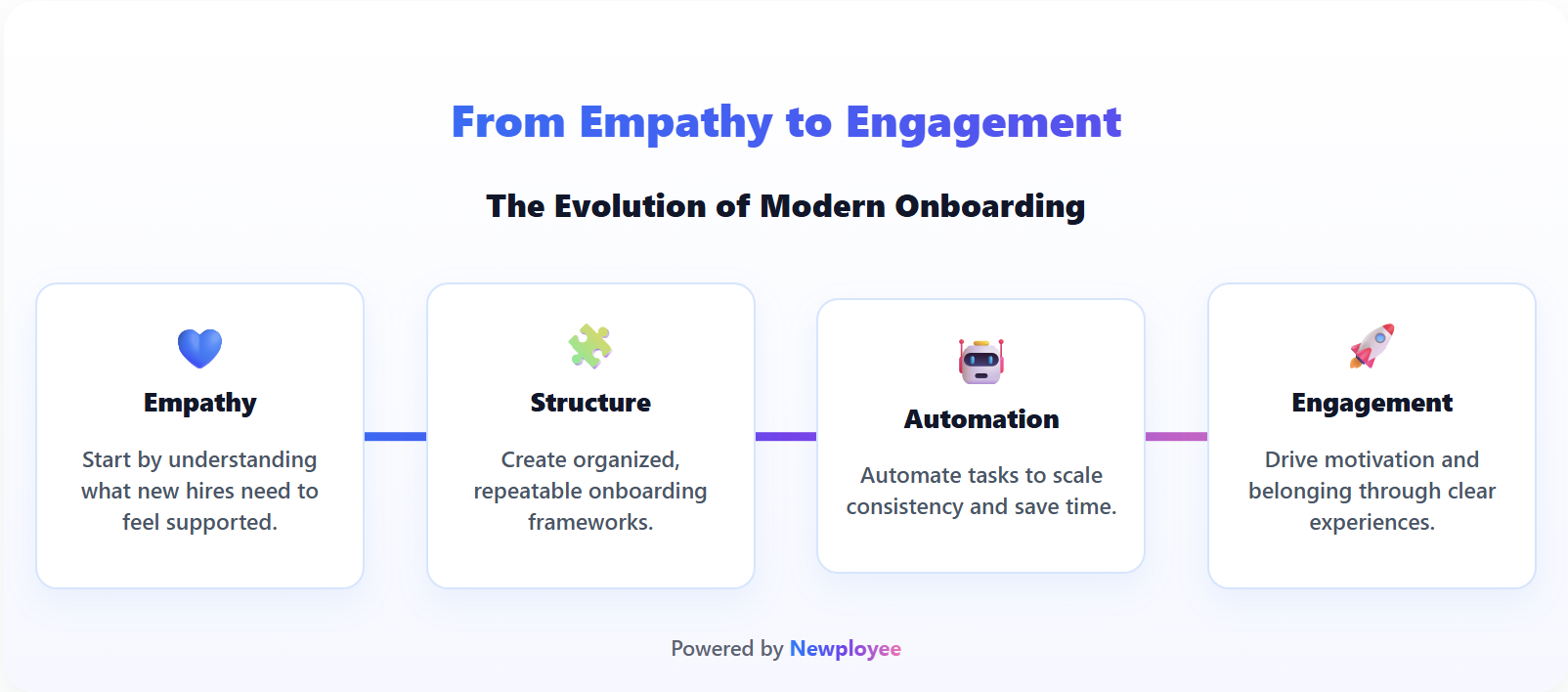
The Takeaway
Remote onboarding is now the heartbeat of the employee experience.
It shapes first impressions, builds trust, and determines whether people stay.
A thoughtful onboarding system combines technology with care.
It tells every new employee, no matter where they are, that they belong to something organized, intentional, and human.
Step 1: Preboarding Starts Before Day One
The first day is not the beginning of onboarding.
It starts the moment a candidate accepts your offer.
That window between acceptance and day one is a quiet but powerful opportunity to build excitement, confidence, and trust.
Preboarding is not about forms or administration.
It is about connection, clarity, and making the new hire feel part of something before they even log in for the first time.
Welcome Message and Digital Introduction
A personalized welcome message creates anticipation and emotion.
Instead of a generic “We’re excited to have you,” add warmth and clarity.
Introduce the team briefly, share a few fun details about company culture, and explain what will happen next.
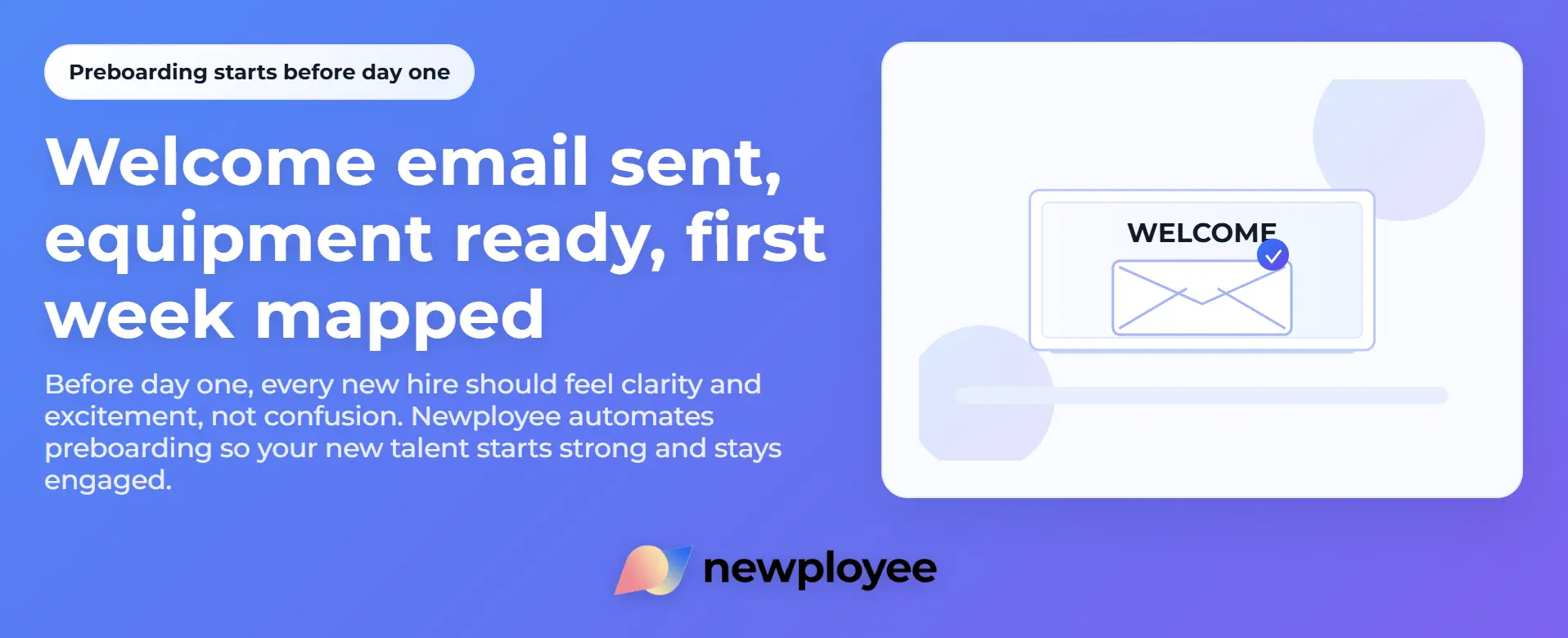
A one-minute greeting from the manager or CEO turns formality into genuine connection.
It tells the new hire they matter.
Sending Equipment and Setting Up Access
Few things kill excitement faster than starting a new job with no tools ready.
Preboarding should include all the logistics: laptops shipped, accounts created, credentials shared.
Everything a new hire needs should be ready before they ask for it.
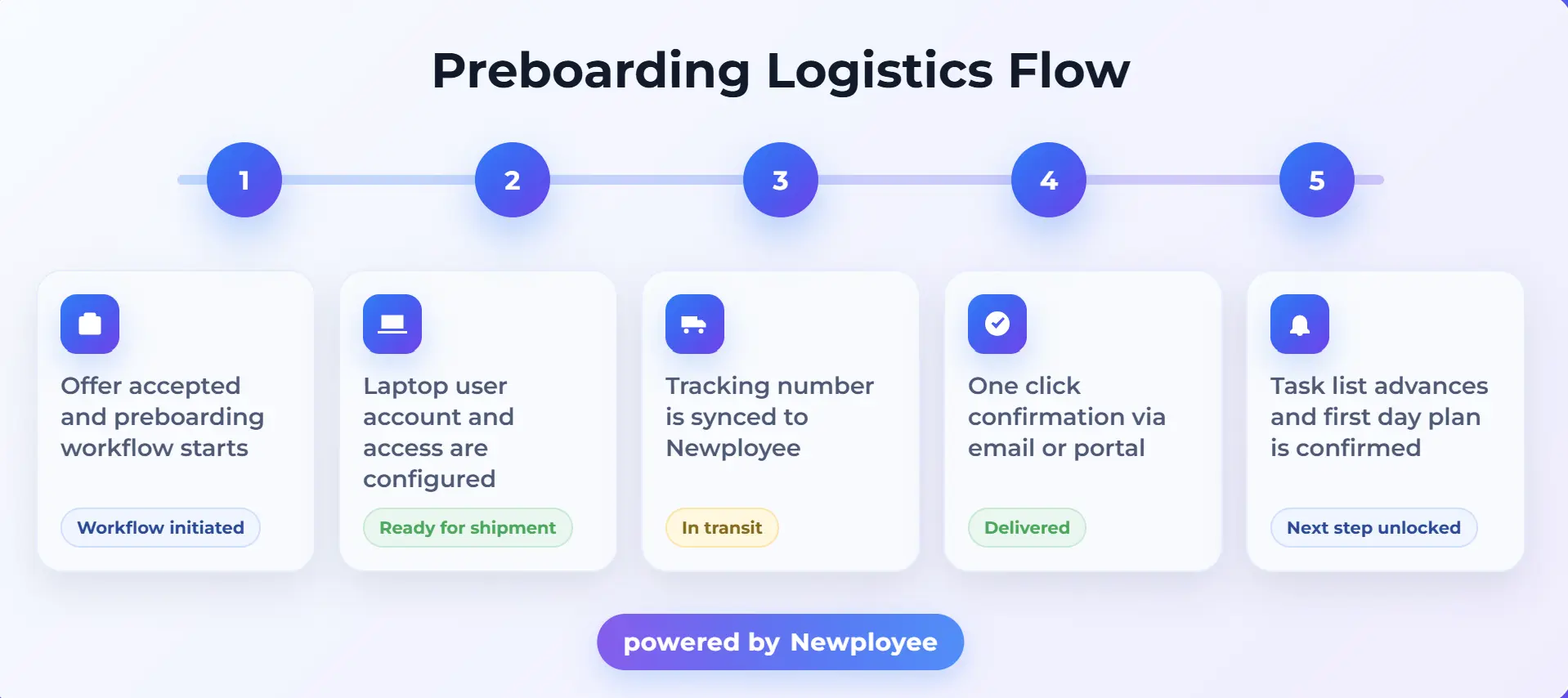
Automating these tasks through Newployee ensures consistency.
When HR marks “Offer accepted,” it can trigger a chain of events that notifies IT, creates user accounts, and sends shipping details to the courier.
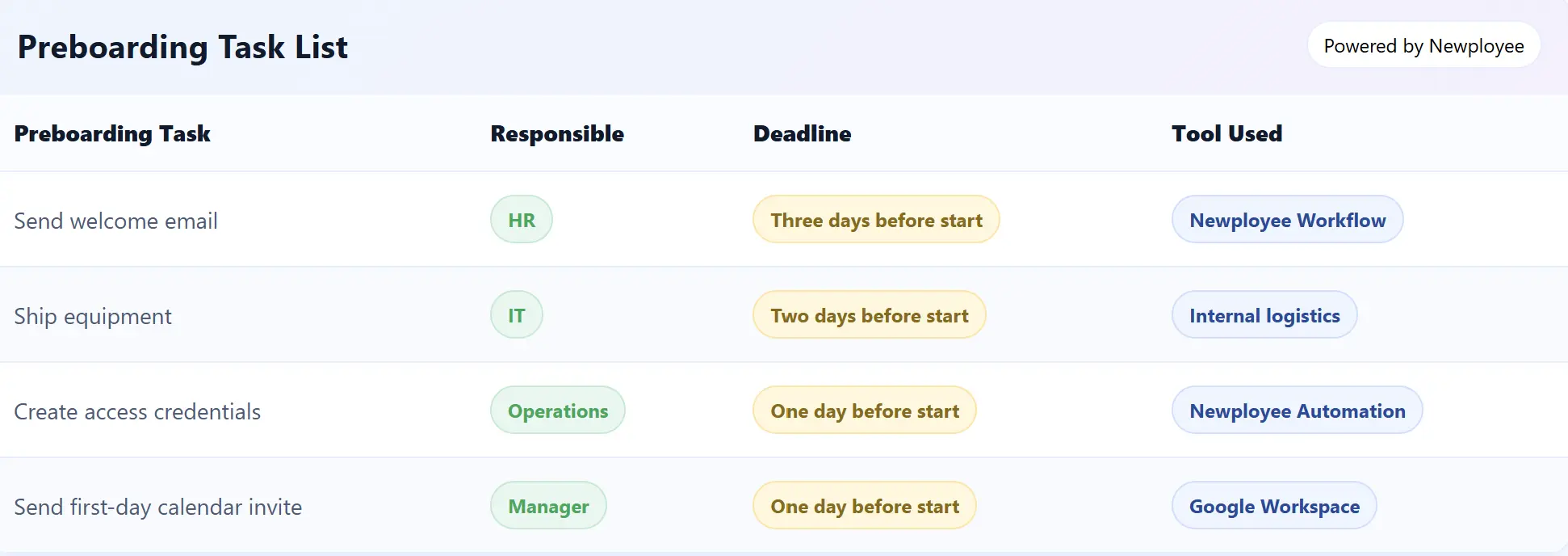
Sharing the First-Week Roadmap
The first week is overwhelming for most new hires.
They do not know what to expect or where to focus.
A clear roadmap replaces uncertainty with structure.
Share a schedule that outlines meetings, introductions, training sessions, and social moments.
It does not have to be detailed hour by hour, the goal is predictability, not pressure.
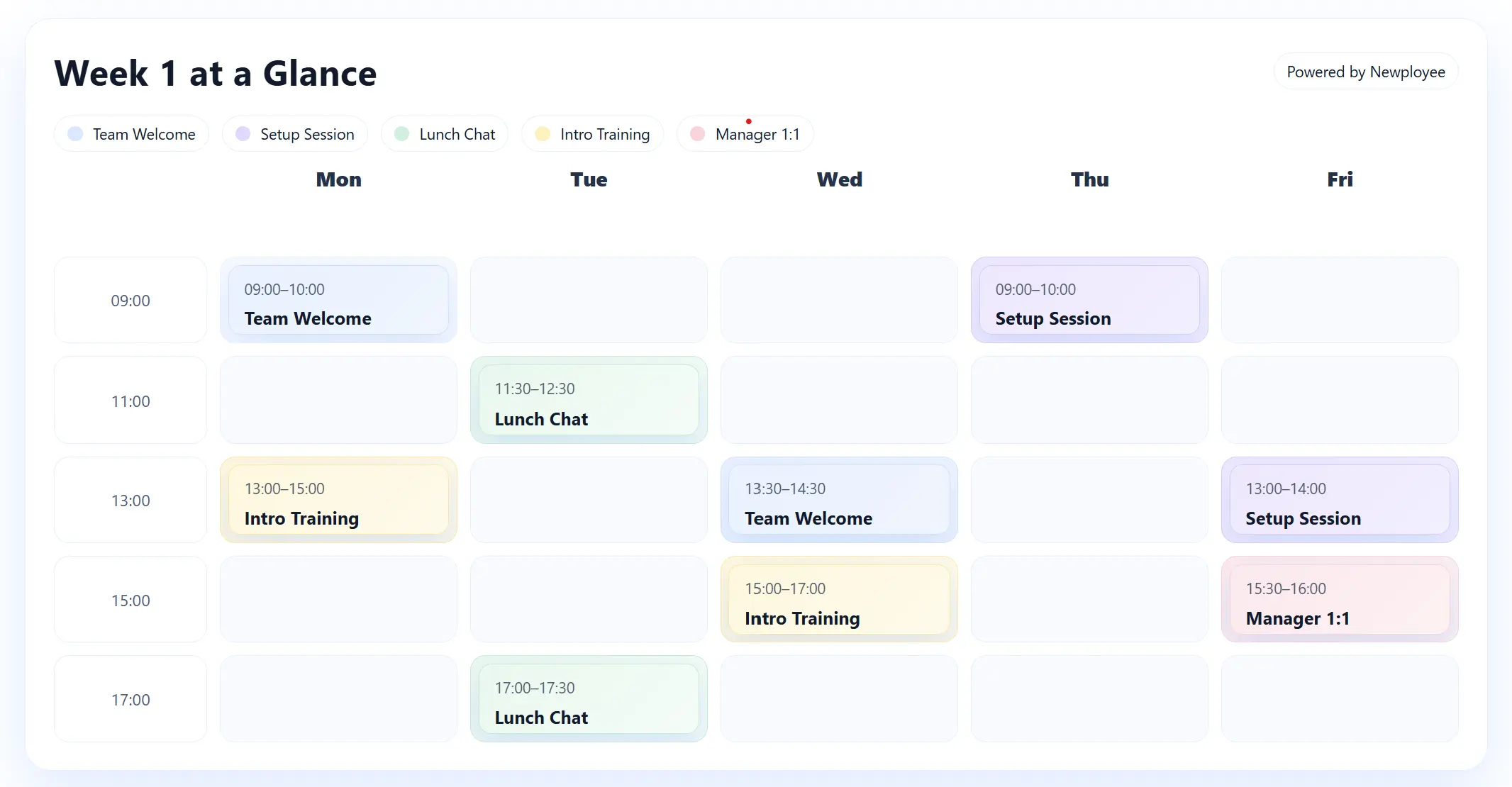
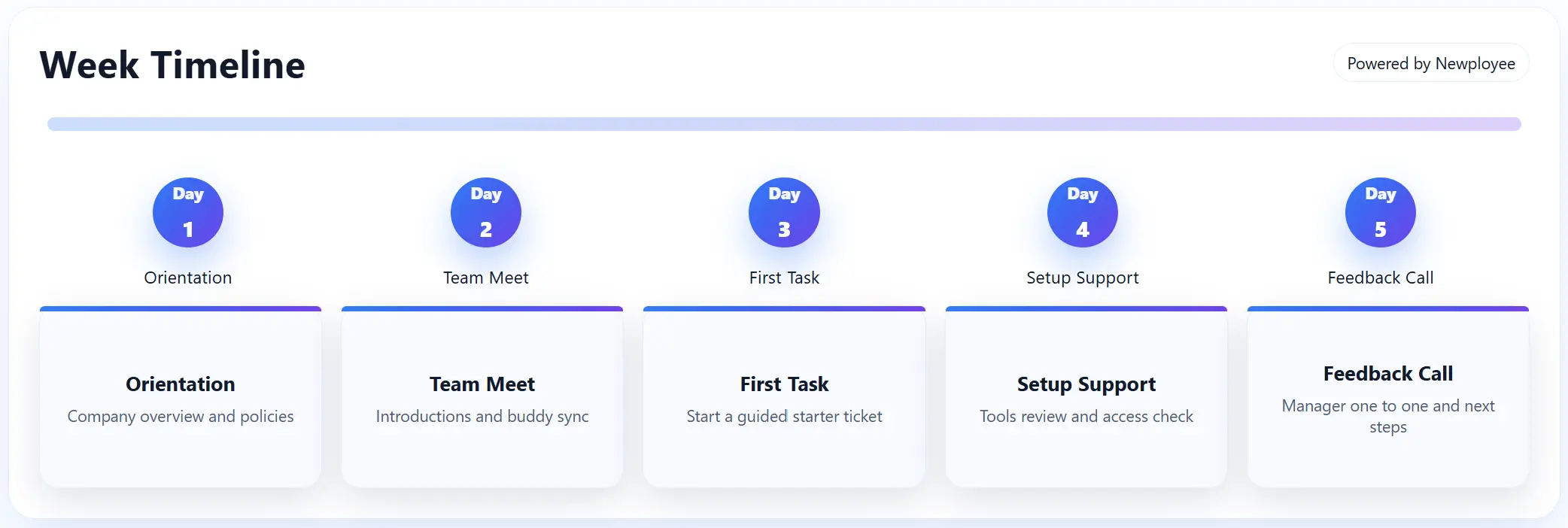
With Newployee, the roadmap can appear automatically in the new hire’s onboarding dashboard, updating as each task is completed.
Assigning a Buddy
Remote hires often worry they will feel isolated.
Assigning a “buddy” eliminates that fear immediately.
A buddy is not just someone to answer questions, they represent belonging and culture in action.
Choose someone who is approachable, positive, and familiar with both company tools and informal communication.
Encourage the buddy to reach out before day one and schedule a short chat.
Buddy systems also benefit existing employees, who strengthen their sense of ownership by helping others succeed.
Collecting Early Feedback
The best preboarding programs listen, not just inform.
Before day one, send a short feedback survey with one or two questions.
Ask how clear communication has been or whether they feel prepared.
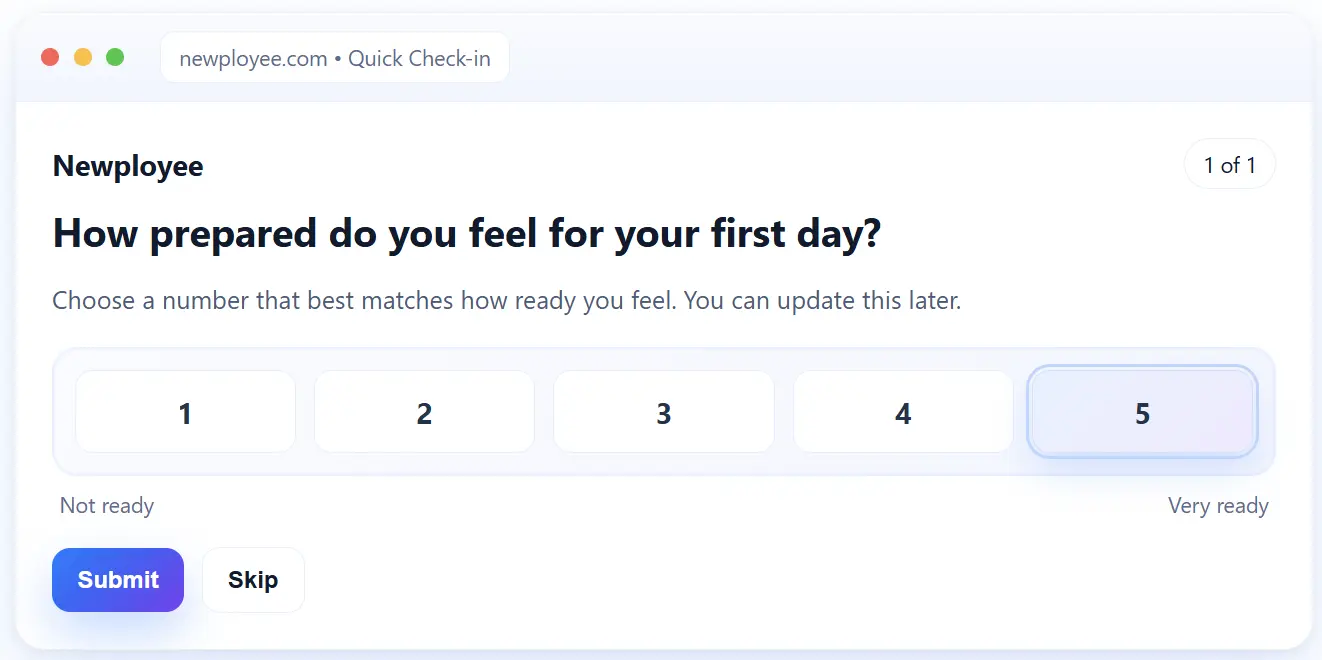
This early check-in sends a message: “We care about your experience.”
It also gives HR valuable insights to fix small issues before they grow.
With Newployee, these surveys can be fully automated.
The system can collect feedback, analyze trends, and notify HR if a new hire reports low readiness, enabling proactive support instead of late reactions.
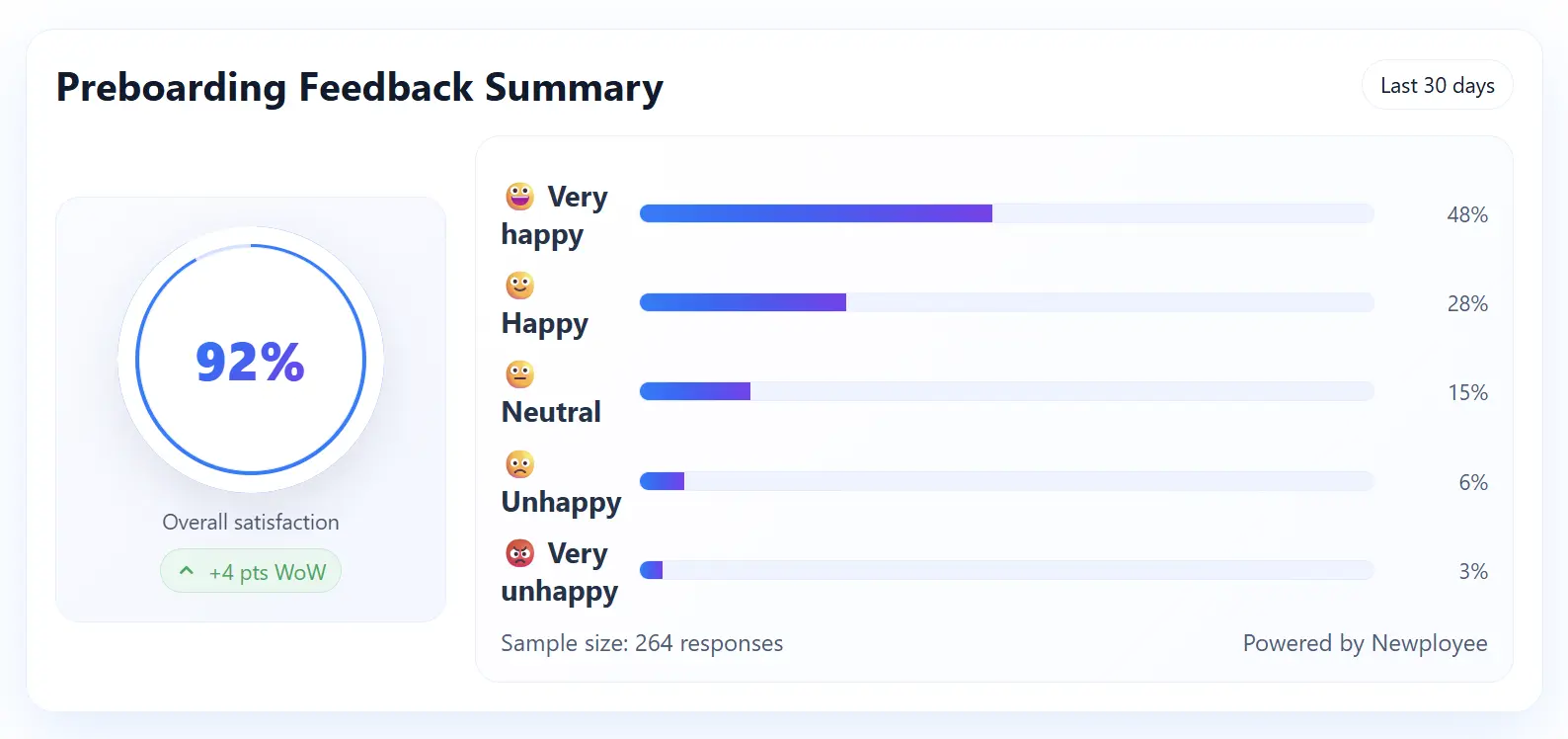
The Power of Preboarding
Preboarding is your first chance to prove that your company is organized, caring, and human.
It turns the gap between offer and day one into a meaningful, structured, and emotional beginning.
Every email, every checklist, every reminder contributes to the same message: We are ready for you.
Newployee brings structure to that promise, automating the logistics so HR teams can focus on what matters most: connection.
Step 2: Make Day One Feel Personal (Even from Miles Away)
The first day defines how your new hire feels about your company for months to come.
It is not about overwhelming them with information but about making them feel seen, supported, and connected from the very first hour.
A structured and personal first day tells your employees: You are part of something real, even if we are miles apart.
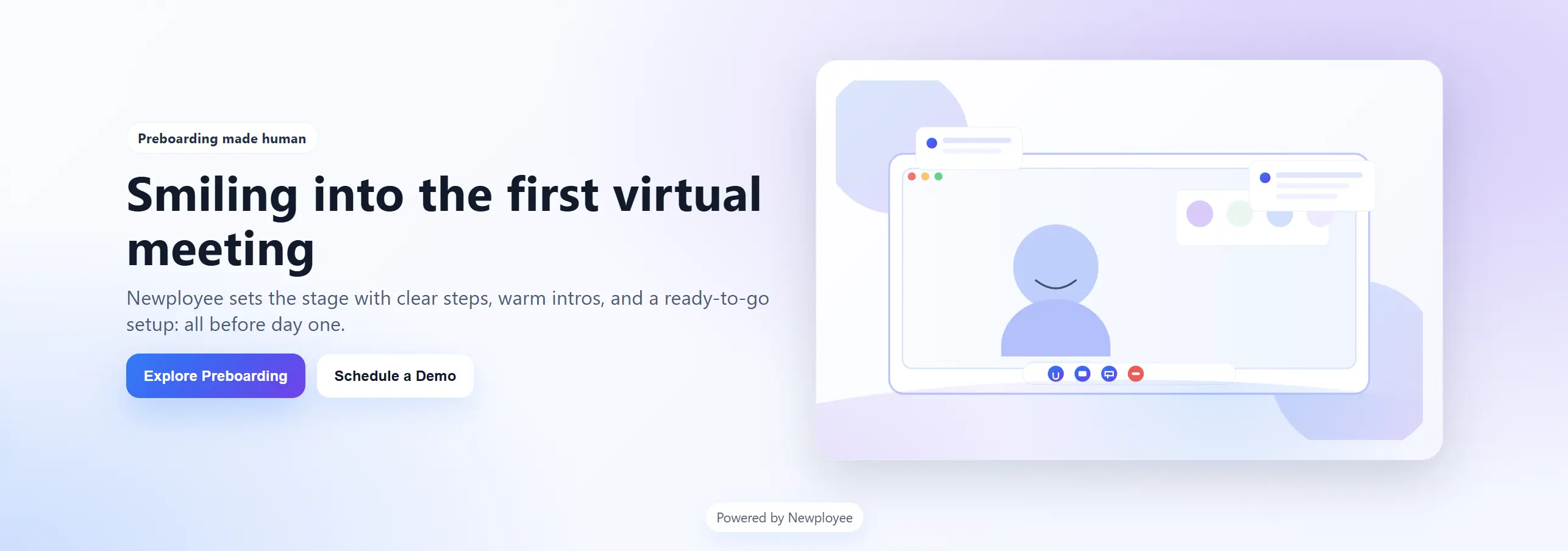
Start with a Personal Welcome
The first message a new hire receives should feel human, not automated.
A short personalized Slack message or email from their manager sets the tone immediately.
It should include warmth, direction, and a small touch of personality.
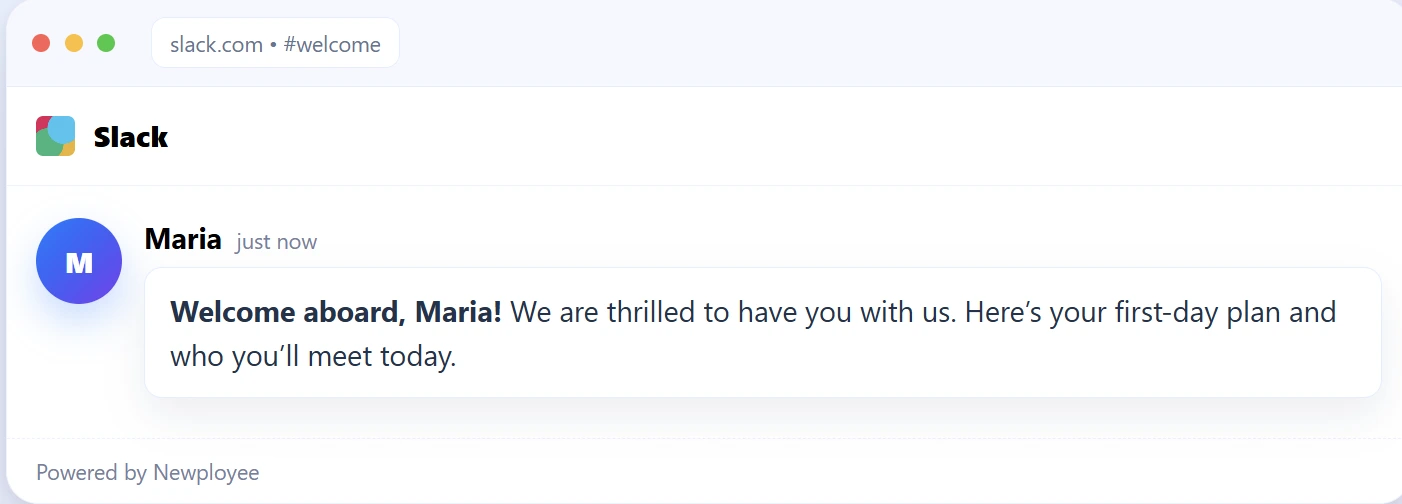
A short video message is even more powerful.
A manager or CEO introducing themselves in a one-minute video adds a genuine human face to the experience.
It helps bridge the physical distance of remote work and creates emotional connection instantly.
Share a Structured Day-One Agenda
The first day should not feel like wandering.
Remote employees crave structure because it replaces uncertainty with confidence.
Send a clear, hour-by-hour outline that includes onboarding sessions, introductions, breaks, and time for reflection.
This ensures they always know what to expect next.
Newployee can automate this by sending a dynamic “Day One Schedule” directly to the new hire’s dashboard and syncing it with their calendar.

Hold a Virtual Coffee Chat or Team Intro
Culture does not happen through slides; it happens through people.
Schedule an informal team call where everyone joins with cameras on and introductions stay lighthearted.
Encourage sharing hobbies, favorite foods, or even pets, anything that sparks warmth and laughter.
Small social rituals matter more remotely.
A virtual coffee chat after the first meeting lets new hires ask questions in a relaxed space.
It turns onboarding from a formality into a relationship.
Celebrate Publicly
Make new hires feel visible.
A simple company-wide announcement on Slack or a “New Faces” post in the internal newsletter makes a huge impact.
Public recognition tells the entire team that welcoming new people is part of the culture.
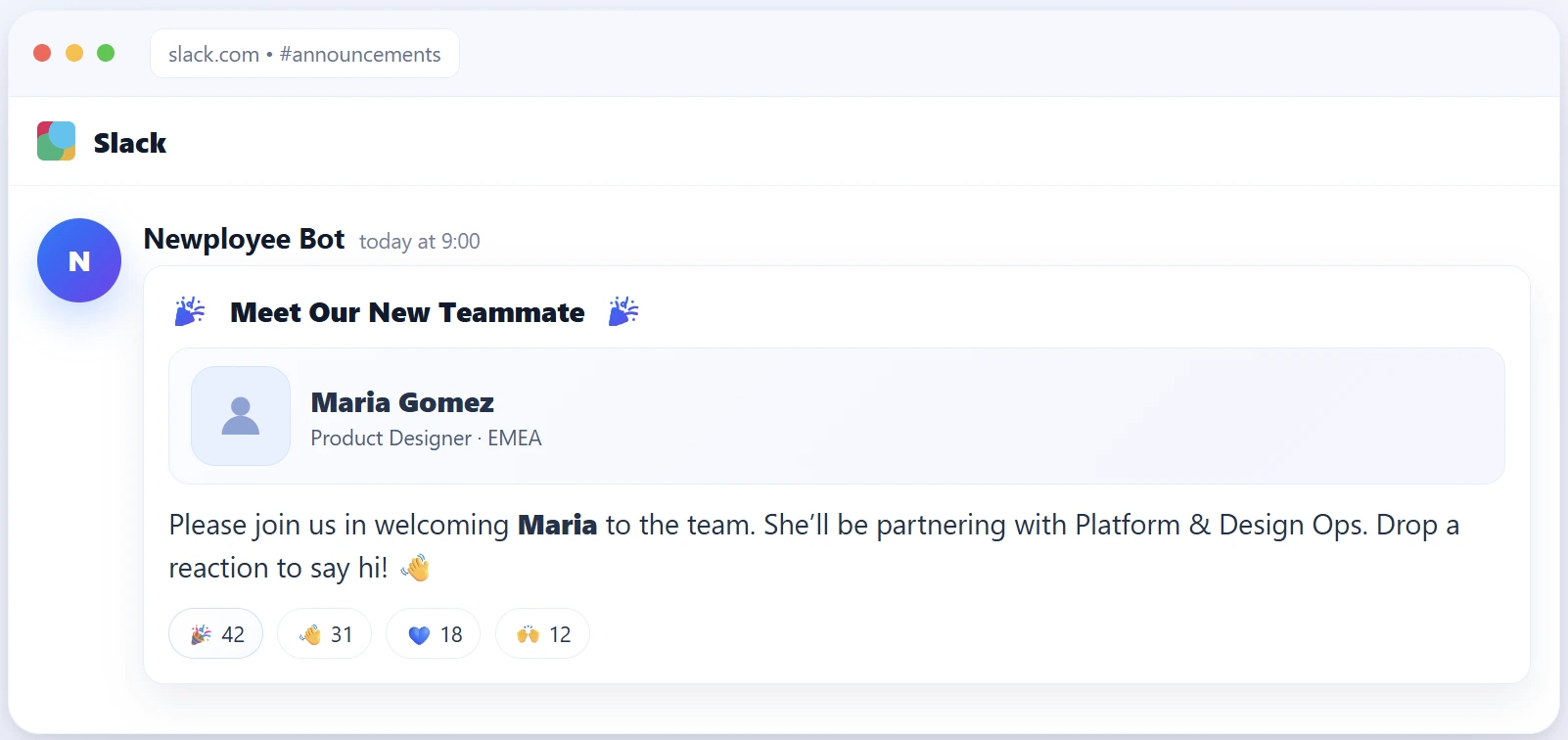
Even small details, like sending a digital welcome card signed by the team, help transform a remote process into a collective experience.
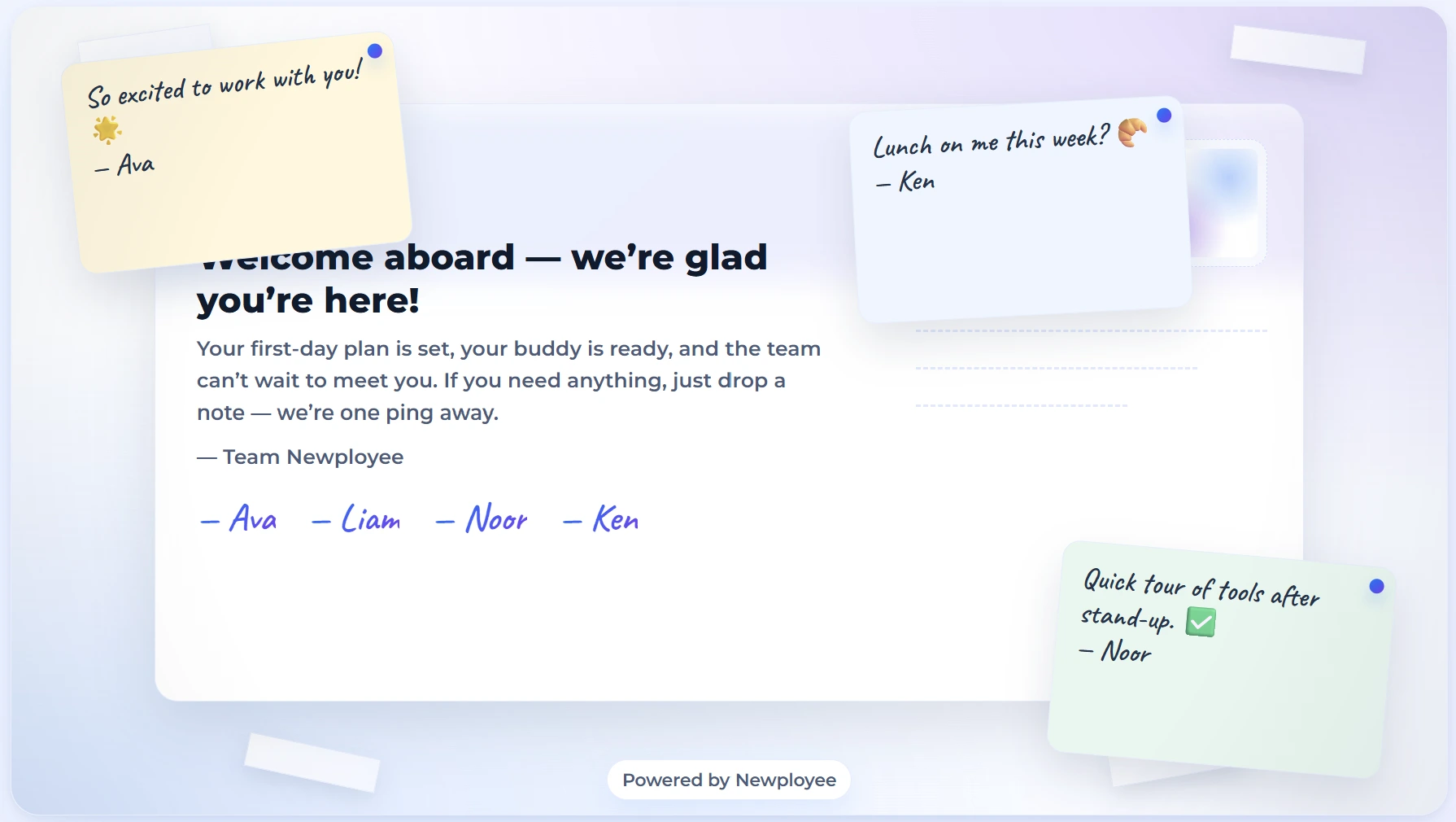
Use Automation to Handle Timing and Consistency
Behind every smooth experience lies precision.
Automation ensures that welcome messages, equipment checklists, and introductions happen on time without manual follow-ups.
Automation does not remove the human touch; it preserves it by freeing HR teams from repetitive tasks.
It allows people to focus on empathy while technology handles logistics.
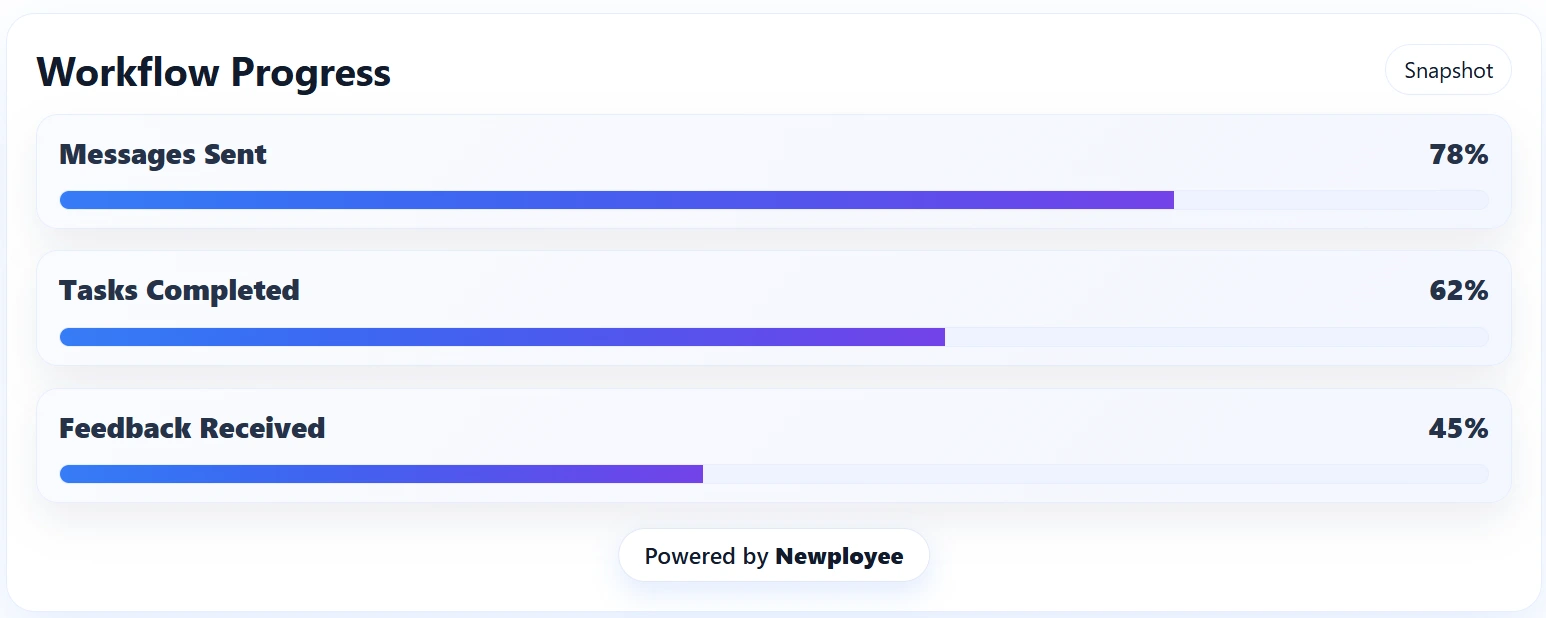
Turning Day One into a Memory
A new hire will forget half the information they receive but never how they felt.
Day one is the emotional foundation of their employee journey.
When every detail, from the first message to the final survey, is intentional, the result is connection.
That connection is what transforms employees into advocates and onboarding into belonging.
Step 3: Connect Early and Often
Connection is the foundation of every healthy remote culture.
Without it, even the most talented employees lose motivation quietly over time.
In an office, relationships grow naturally through shared spaces and casual moments.
In remote environments, those moments must be created intentionally and consistently.
The first month is the bridge between onboarding and belonging.
It is where trust is built, culture becomes visible, and collaboration starts to feel natural.
Schedule Recurring Check-ins with Manager and Peers
A single first-day meeting is never enough.
Connection grows through rhythm and repetition.
Set up weekly one-on-one meetings between the new hire and their manager.
Keep them short but consistent, even 15 minutes can strengthen alignment and trust.
Encourage managers to focus less on performance metrics and more on how the employee feels.
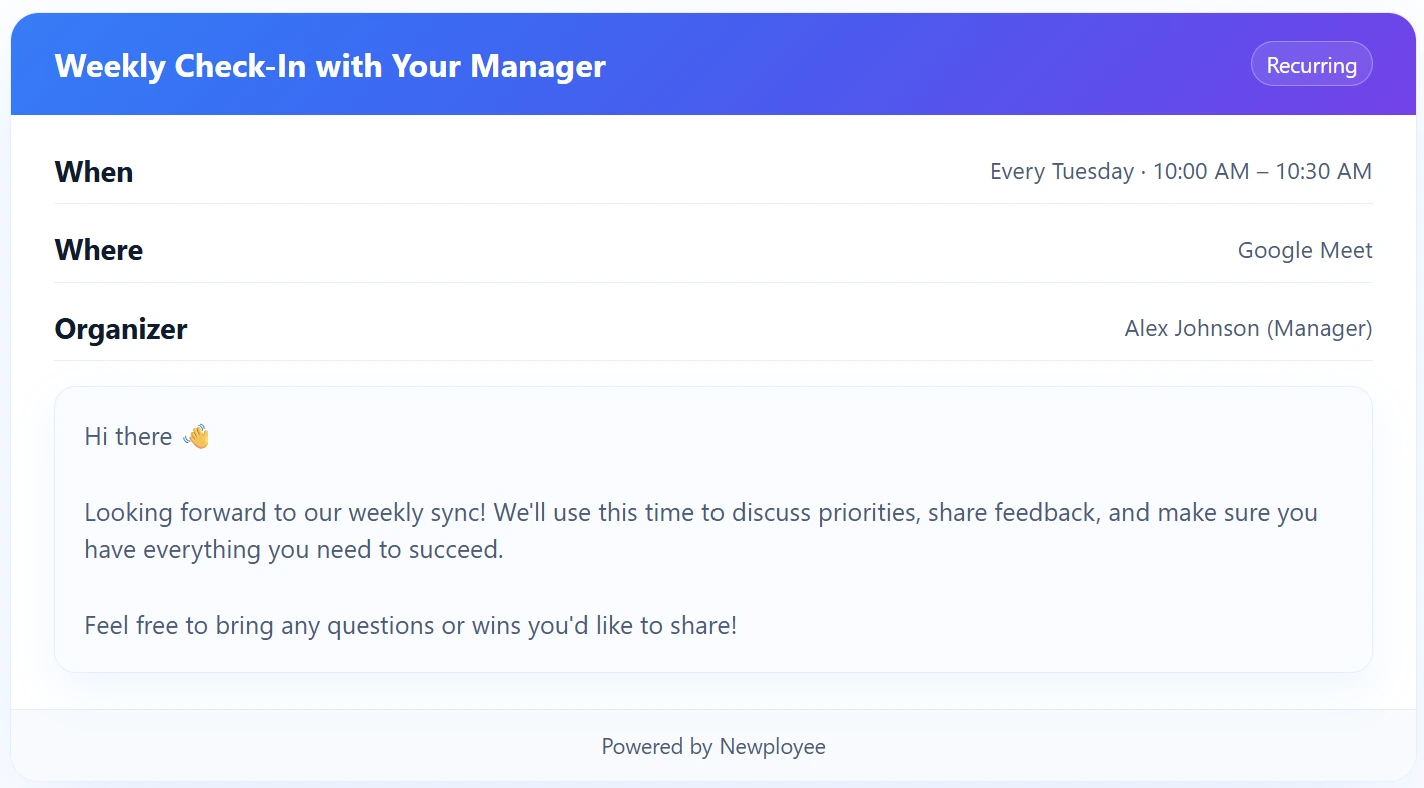
Peer check-ins are equally powerful.
Pair new hires with teammates from different departments to help them understand the company beyond their direct team.
These informal conversations create cross-functional empathy early on.
Encourage Cross-Team Introductions
One of the hardest parts of remote work is understanding who does what.
New hires often know their immediate team but struggle to connect the bigger picture.
Design a simple onboarding ritual that introduces them to key people across departments.
Instead of overwhelming introductions, spread them across the first few weeks, one new person at a time.
These moments build bridges that make collaboration natural later on.
When employees understand how their role connects to others, they make better decisions and feel more ownership.
To make this effortless, Newployee can automate introduction reminders, sending both parties a prewritten message like,
“This week’s intro: Meet Emma from Product Design. Grab a 15-minute chat to learn how your roles connect.”
Introduce Async Communication Best Practices
Remote work relies on asynchronous communication.
Not every conversation needs a meeting, but every message needs clarity.
New hires often feel unsure about when to respond, how to document progress, or what tools to use for each type of communication.
Early guidance helps them adapt faster.
Provide examples of good and poor communication so they can model their own messages.
Encourage teams to use consistent structures when sharing updates.
This creates predictability, which builds psychological safety.
Async communication is not just efficient.
It allows people in different time zones to work with balance and focus, reducing pressure while improving collaboration.
Use Automated Surveys to Collect Engagement Feedback
The first month is the perfect time to listen closely.
Short pulse surveys give HR teams real data about how onboarding feels in practice.
Ask questions such as
- “Do you feel connected to your team?”
- “How clear is your role so far?”
Keep it quick and consistent so employees respond honestly.
Automated surveys in Newployee help HR teams act in real time.
If a new hire rates connection low, the system alerts managers to schedule a check-in.
This transforms feedback from a report into an early signal for action.
The Essence of Connection
Connection is not a single meeting or message.
It is a rhythm that keeps people aligned emotionally and professionally.
When companies design connection deliberately, they replace distance with belonging.
Each check-in, introduction, and survey becomes a quiet way of saying “You matter here.”
Newployee makes that rhythm sustainable by automating what needs precision and leaving space for what needs empathy.
The result is a workplace where technology strengthens humanity instead of replacing it.
Step 4: Build Role Clarity and Confidence
When a new hire joins a company, their biggest question is rarely “What tool do I use?”
It is “What exactly am I supposed to achieve here, and how will I know if I am doing well?”
Role clarity answers that question. It turns uncertainty into direction and anxiety into momentum.
For HR professionals, this is one of the most overlooked yet critical parts of remote onboarding.
Without structure, even talented hires lose energy in confusion. With structure, they become confident, independent, and aligned faster.
Provide a 30-60 -90 Day Plan
A 30 60 90 day plan is more than a timeline.
It is a roadmap that helps employees understand what success looks like at each stage of their journey.
It gives clarity on priorities, expectations, and how their role connects to larger company goals.
Break it into clear, tangible sections:
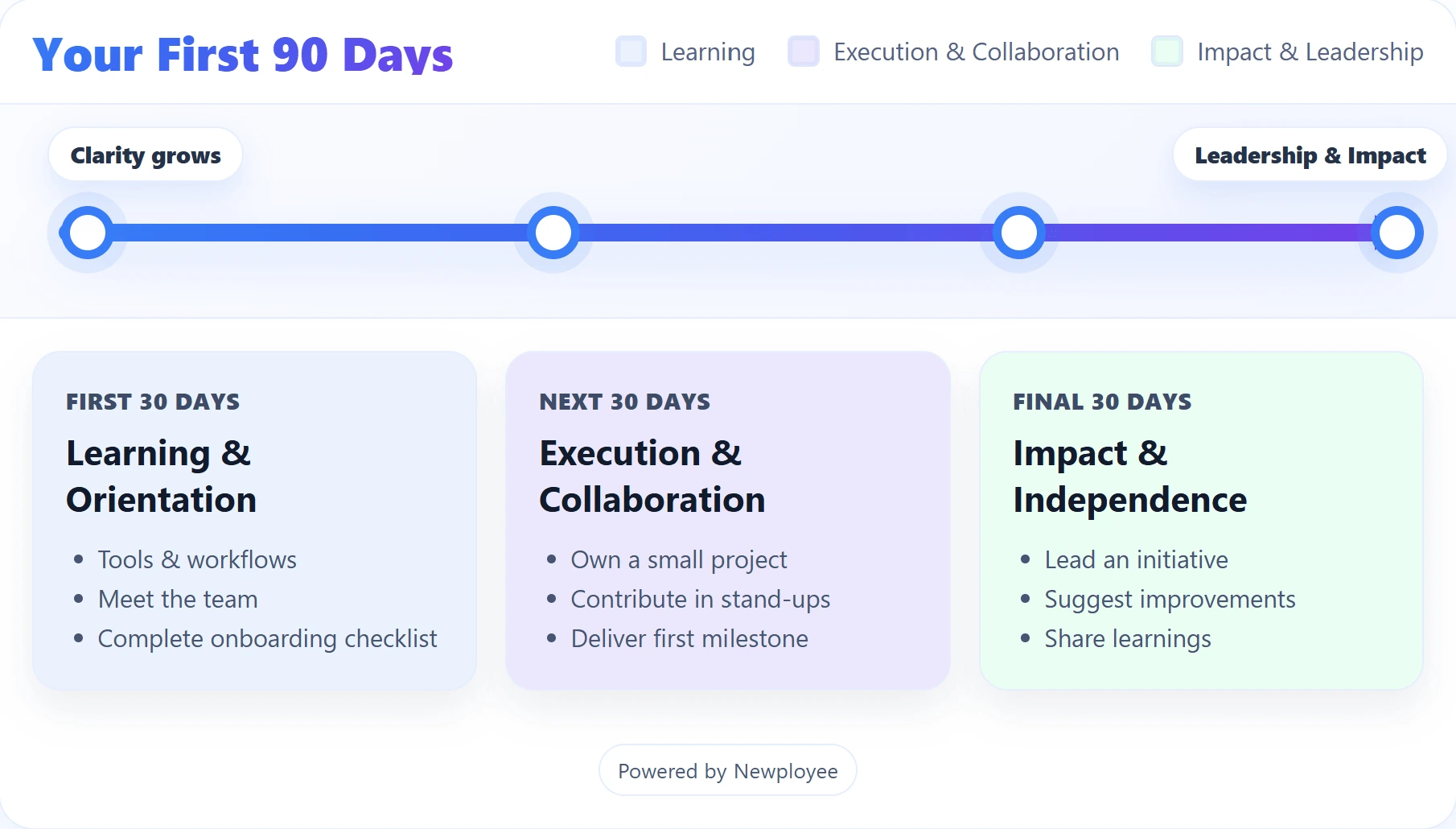
Encourage managers to review this plan together with the new hire during the first week.
The act of creating it together helps both sides align on expectations and trust.
Clarify Goals and Expected Outcomes
Ambiguity destroys motivation faster than failure.
Employees perform best when they know what success looks like and how their work contributes to a larger purpose.
Every new hire should have three clear layers of goals:
- Individual goals: outcomes directly tied to their role
- Team goals: how their work supports collective priorities
- Company goals: how their success aligns with overall business objectives
Encourage managers to make these goals visible in shared tools such as Newployee dashboards, project trackers, or OKR systems.
Visibility helps employees prioritize and measure progress without guesswork.
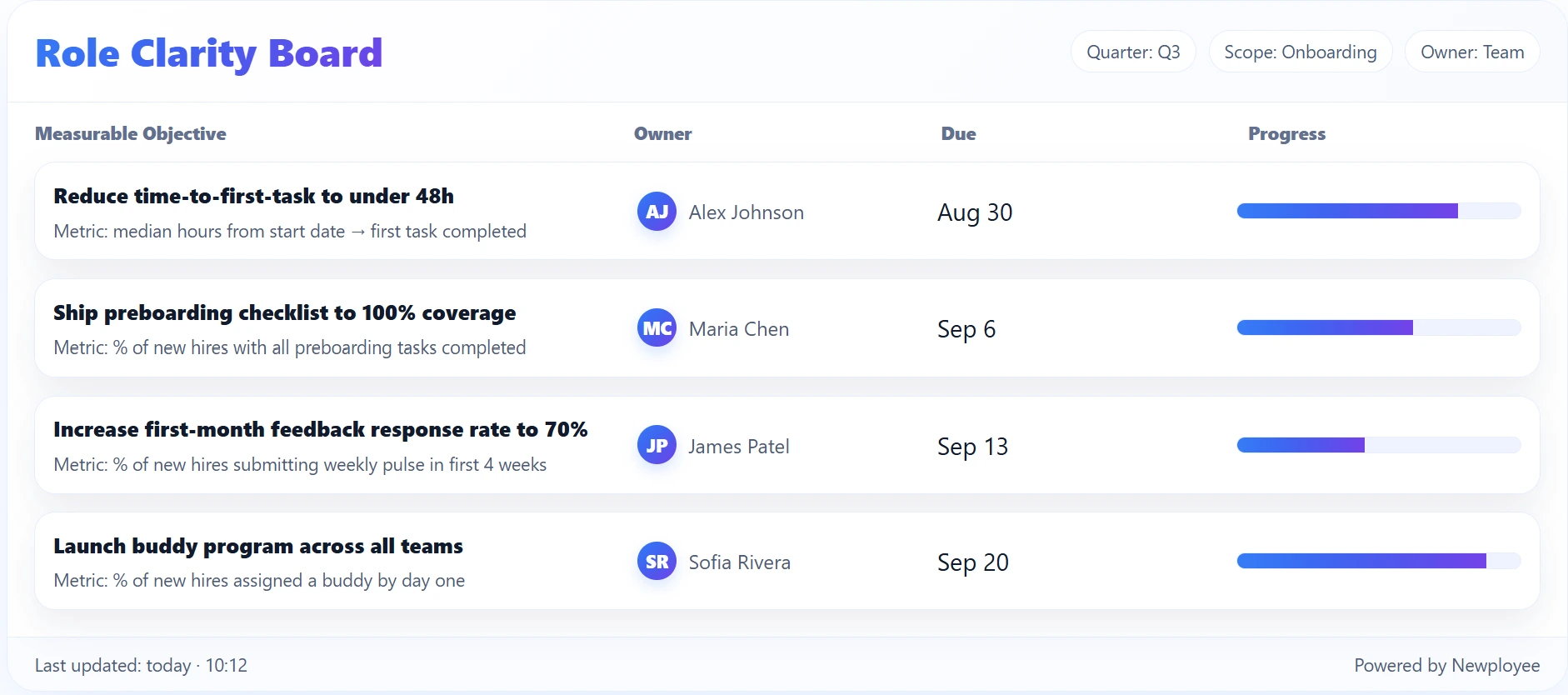
When expectations are visible, accountability becomes natural.
Create Early Wins and Recognition Moments
Confidence grows through progress, not perfection.
Early wins give employees proof that they belong and that their work matters.
These moments do not have to be large.
Completing a small project, helping a teammate, or getting positive feedback in the first few weeks all reinforce confidence and engagement.

Recognition should be timely and specific.
Instead of a generic “Good job,” say “Your first client email was clear and professional. You set a great tone for the team.”
Encourage managers to share wins publicly in Slack or during team meetings.
Public recognition builds belonging and creates positive momentum.
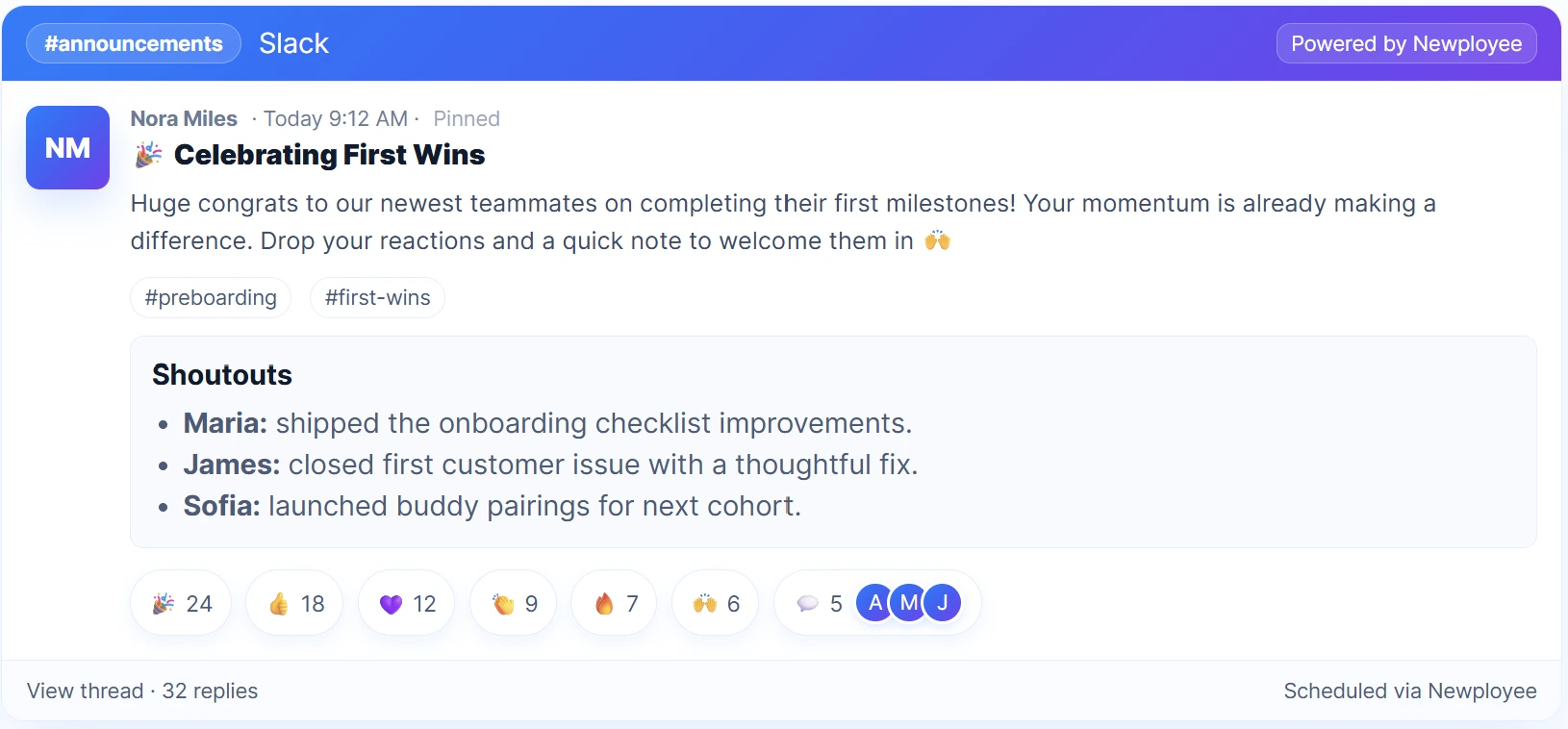
Automate Manager Reminders for Check Ins
Managers balance multiple priorities.
Without reminders, check-ins can easily be forgotten, leaving new hires without guidance.
Automation ensures that support happens at the right time for every employee.
In Newployee, managers can receive smart prompts such as:
- “Schedule your week two feedback conversation”
- “Review your new hire’s 30-day progress”
- “Share a recognition message after the first milestone”
These reminders help managers stay consistent while HR gains visibility into each onboarding journey.friday re
The Impact of Role Clarity
When new hires understand what success looks like, they move faster, make better decisions, and feel part of something meaningful.
Clarity replaces hesitation with confidence, and confidence drives performance.
For HR professionals, role clarity is the foundation of retention.
It prevents quiet frustration and accelerates contribution. It is how great onboarding becomes great performance.
Step 5: Keep Engagement Alive After Week One
The first week is only the beginning.
True onboarding lasts at least ninety days long enough for habits to form relationships to deepen and performance to take shape.
Many companies invest energy in the welcome week and then let the momentum fade.
That silence after week one is where disengagement begins.
HR professionals know that motivation is not built in a day.
It grows through rhythm recognition and real connection.
The goal after week one is simple.
Turn excitement into commitment.
Celebrate Small Milestones
Engagement is emotional not procedural.
Celebrating small wins throughout the first months keeps employees connected to progress and purpose.
Highlight achievements like completing onboarding tasks finishing the first project or hitting the one month mark.
These are emotional anchors reminders that growth is happening and effort matters.
Make celebrations visible.
A public message in Slack or an internal post saying “One month in and already making an impact” amplifies pride and belonging.
Encourage managers to use structured reminders in Newployee so that these moments never get missed.
Automation can prompt a congratulations message or generate a digital badge for completing a milestone.
Encourage Participation in Team Rituals
Team rituals create rhythm and rhythm creates belonging.
Remote employees cannot rely on shared lunches or office chats so culture must be intentionally designed into the workweek.
Introduce recurring rituals that build connection and identity such as:
- Monday kickoff calls where team members share one personal and one professional goal
- Midweek coffee chats for open discussions
- Friday reflection threads in Slack celebrating wins
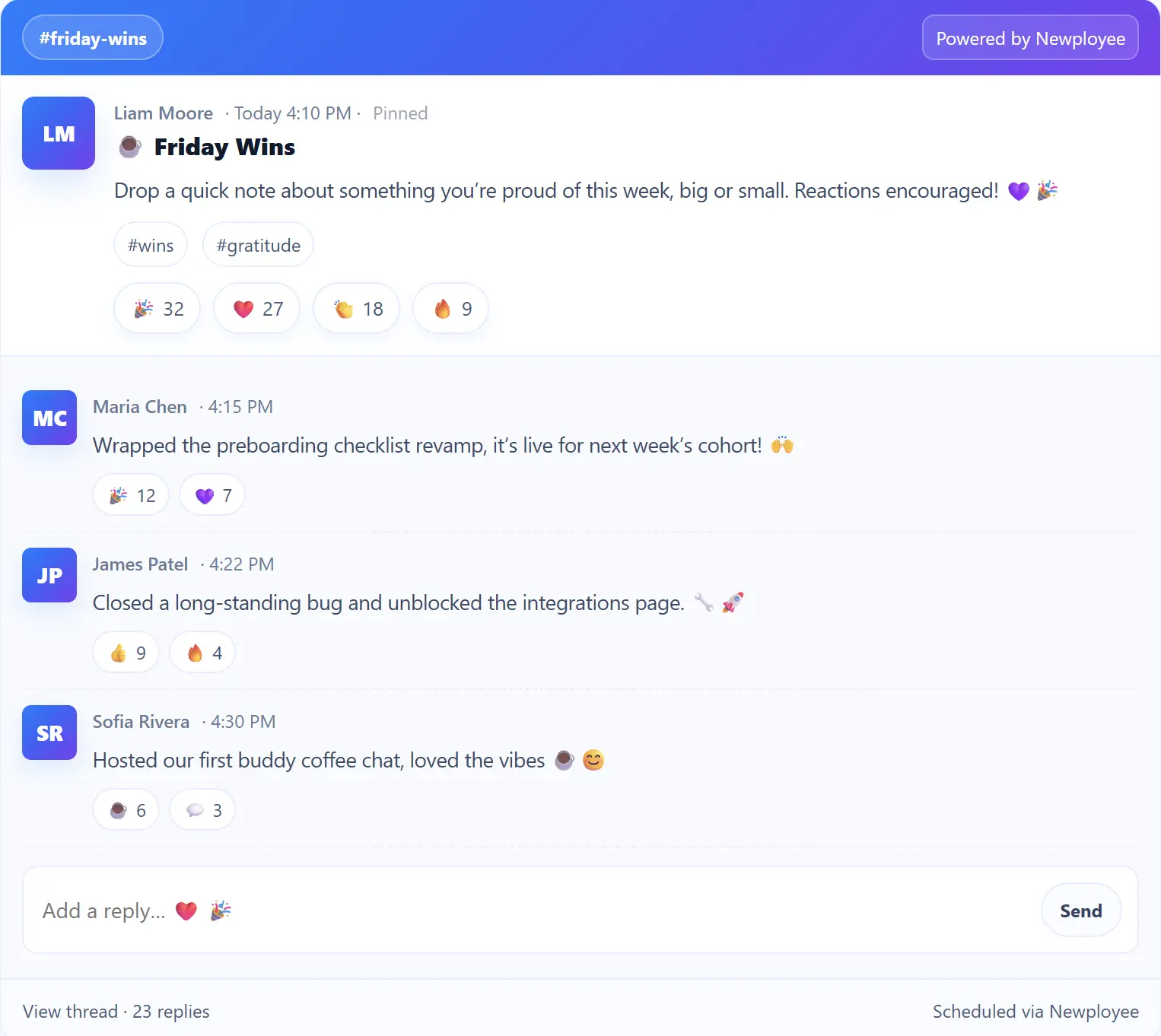
These small but consistent routines help employees find rhythm in a digital environment.
They turn routine communication into a community heartbeat.
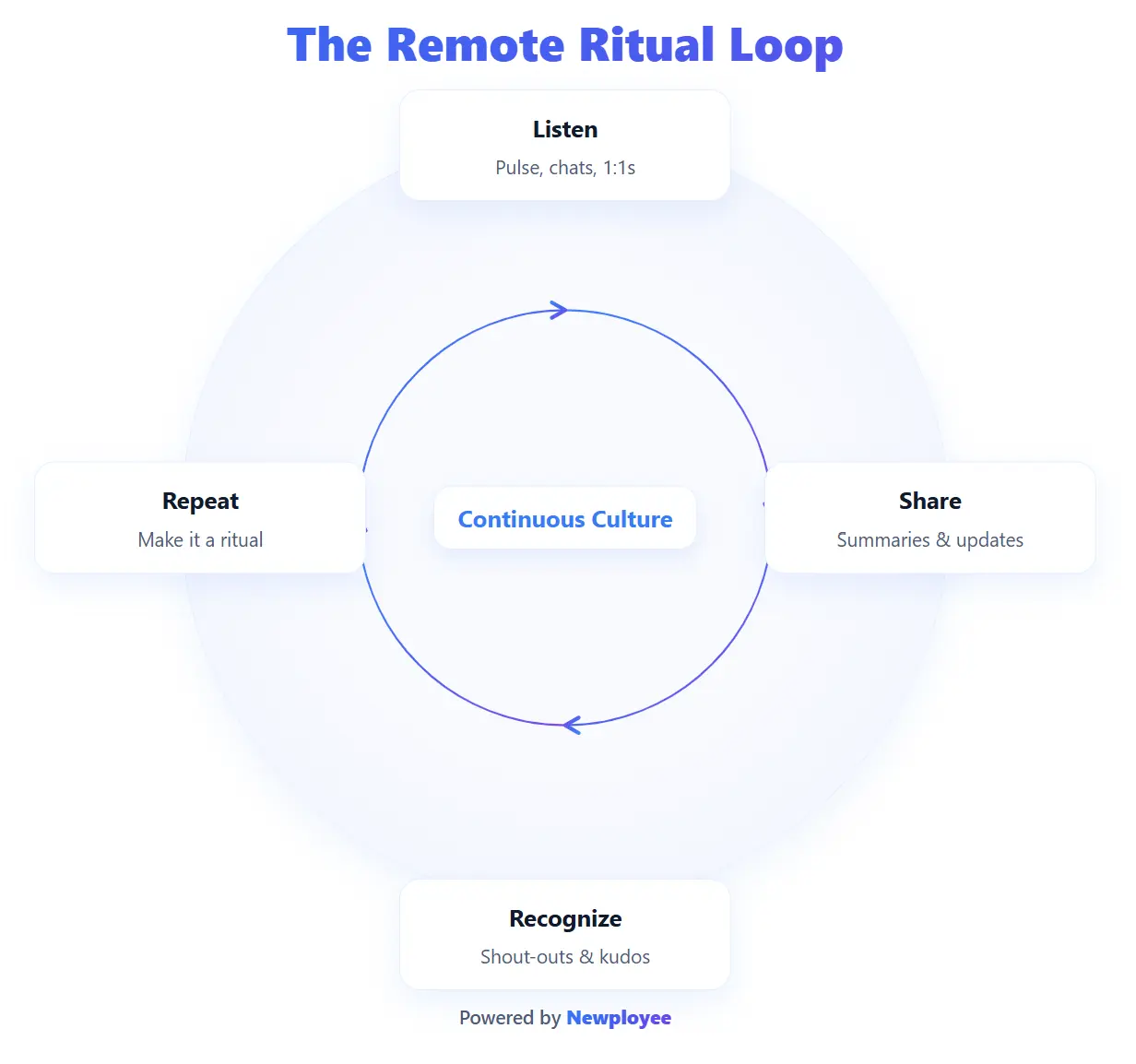
HR professionals can use Newployee to automate reminders for team leads ensuring rituals happen every week no matter how busy schedules become.
Collect Regular Feedback
Engagement cannot be managed by assumption.
What looks fine on the surface may hide confusion loneliness or frustration underneath.
Regular feedback turns onboarding from a static process into a living dialogue.
Send brief surveys at key checkpoints week one week three and month two asking questions such as:
- “Do you feel connected to your manager and team”
- “Is your workload clear and manageable”
“What has been the most helpful part of onboarding so far”
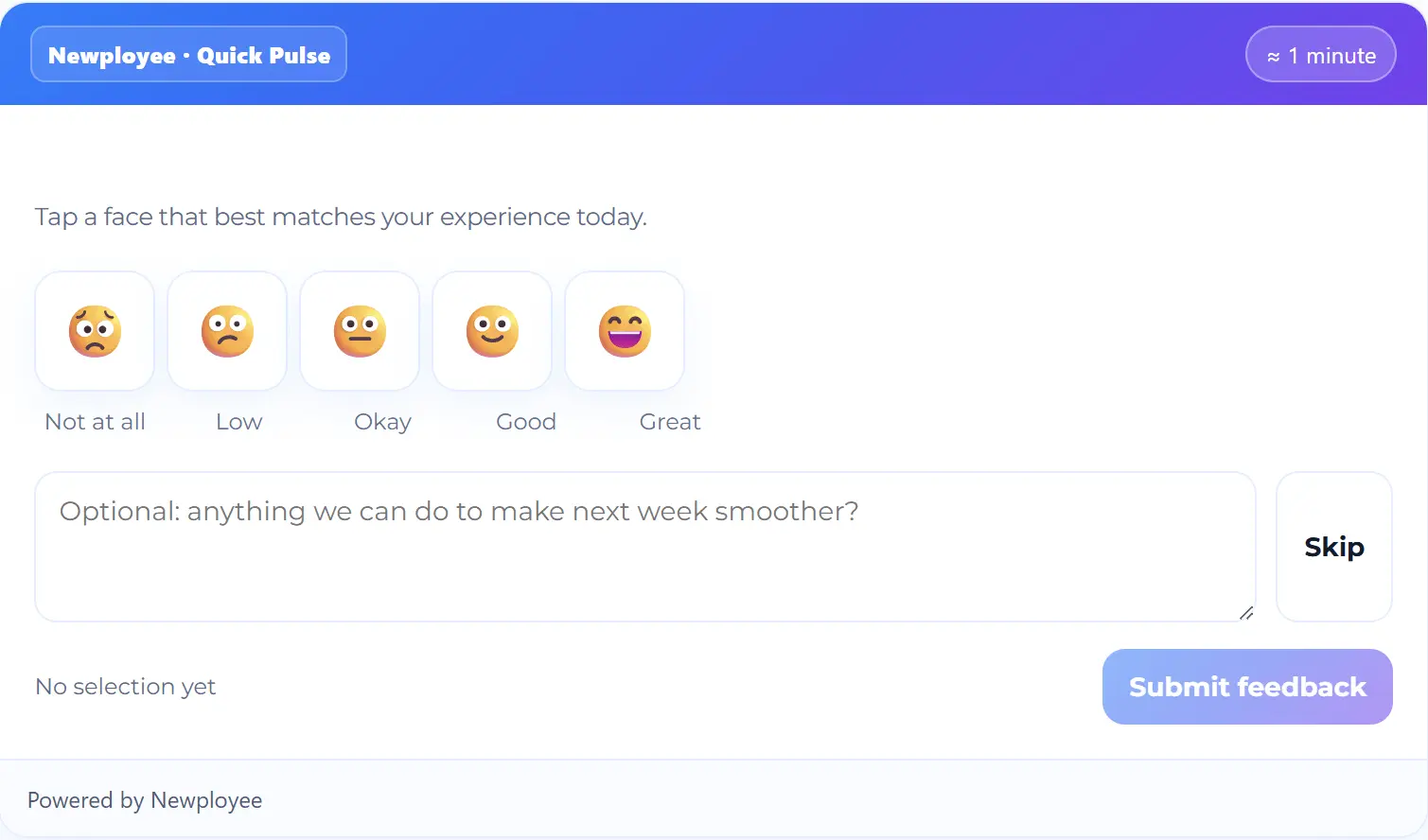
Feedback should never disappear into silence.
Share outcomes transparently with new hires “Here is what you told us and here is what we are improving.”
This builds trust and shows that their voice has impact.
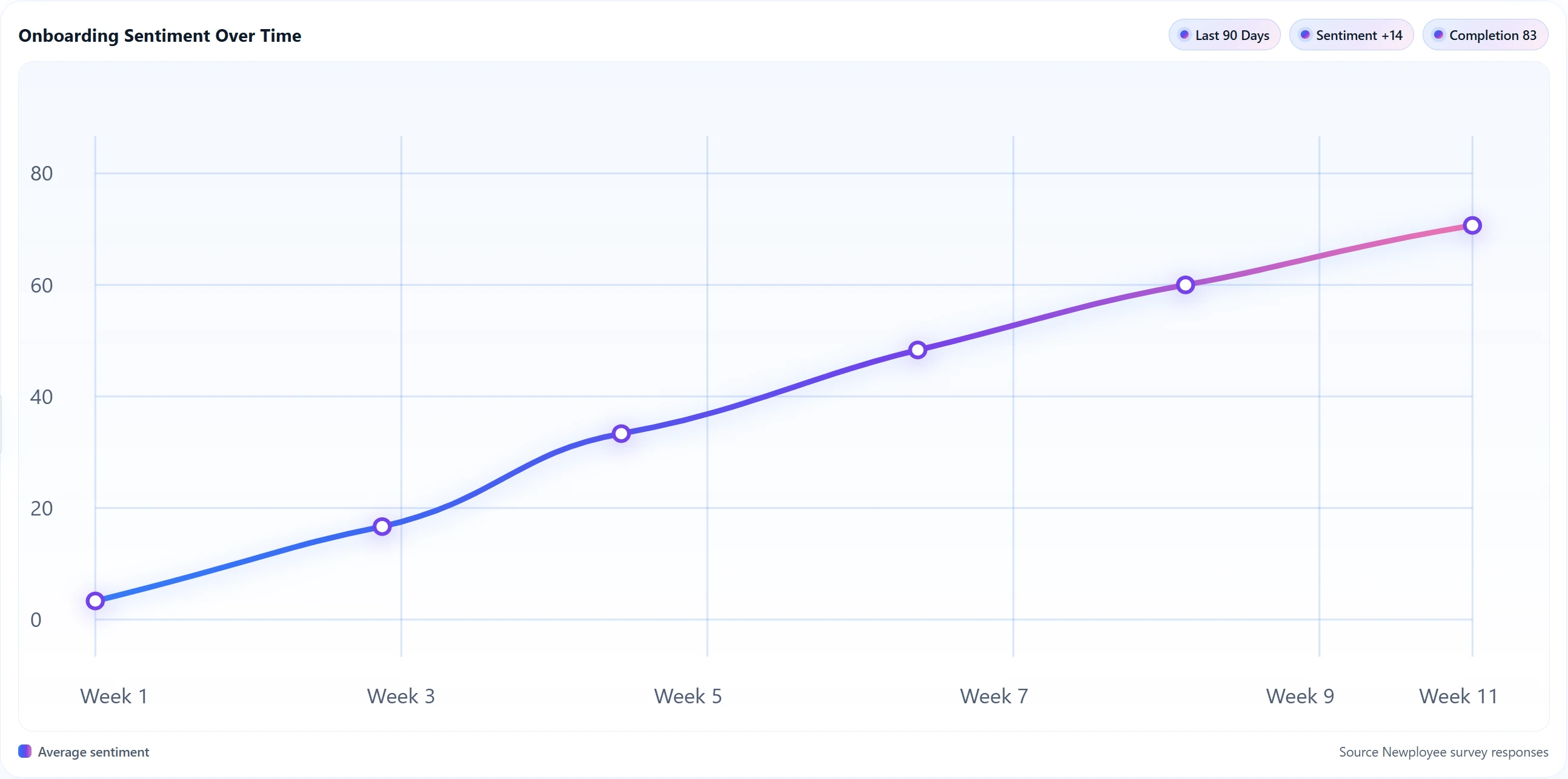
Automated surveys and dashboards in Newployee give HR teams a live pulse of engagement.
They reveal when excitement starts to drop allowing action before disengagement takes hold.
Recognize Achievements Beyond Onboarding
The end of onboarding should not feel like a finish line but a transition into growth.
Recognition is the bridge between new hire and valued contributor.
Encourage managers to celebrate not only completed training but also the first time an employee demonstrates initiative or collaboration.
Recognize contributions publicly even if they seem small.
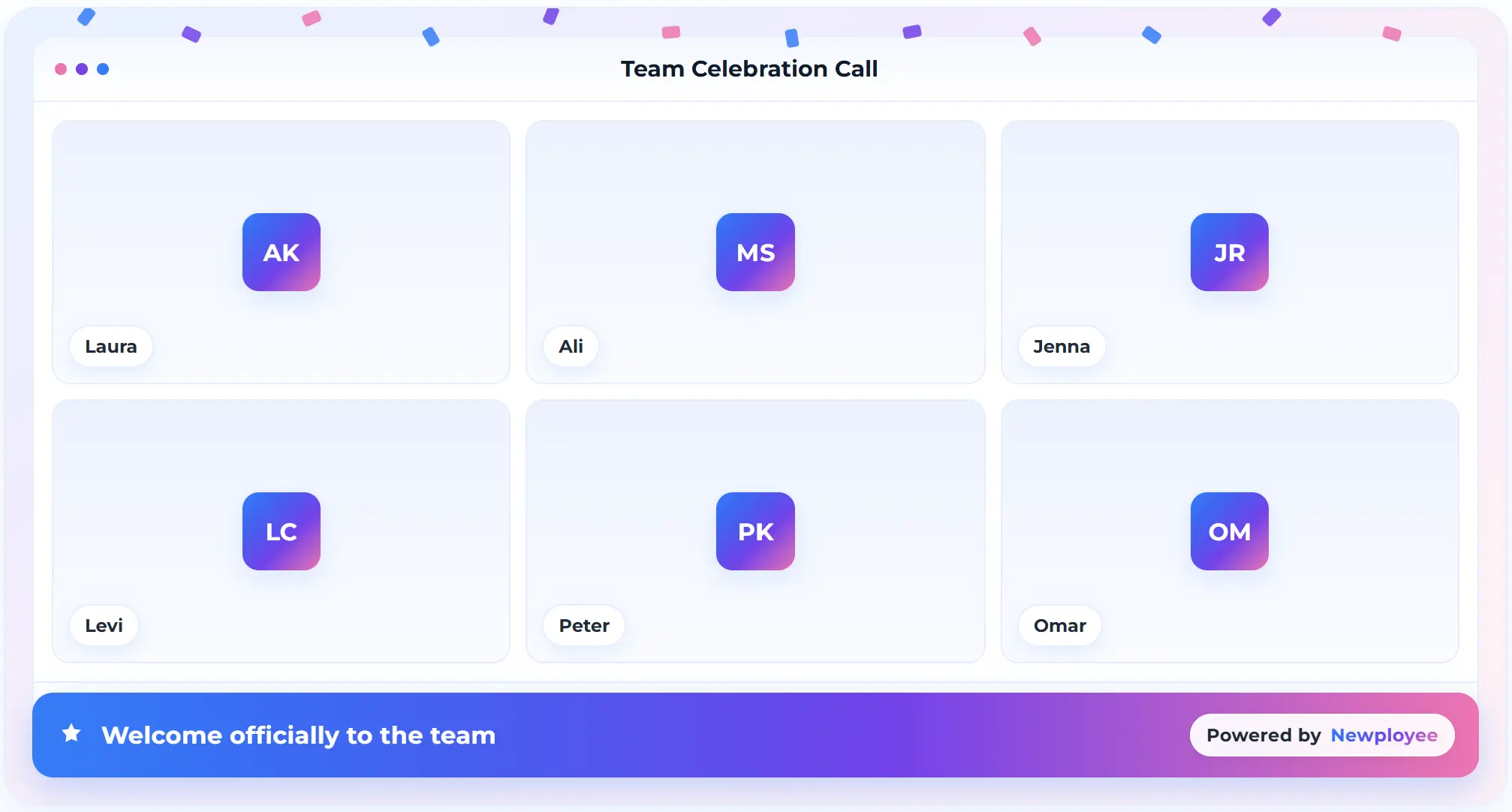
Integrate recognition directly into performance systems.
In Newployee automated workflows can send a Recognition Reminder to managers after major milestones or when a new hire completes their ninety day journey.
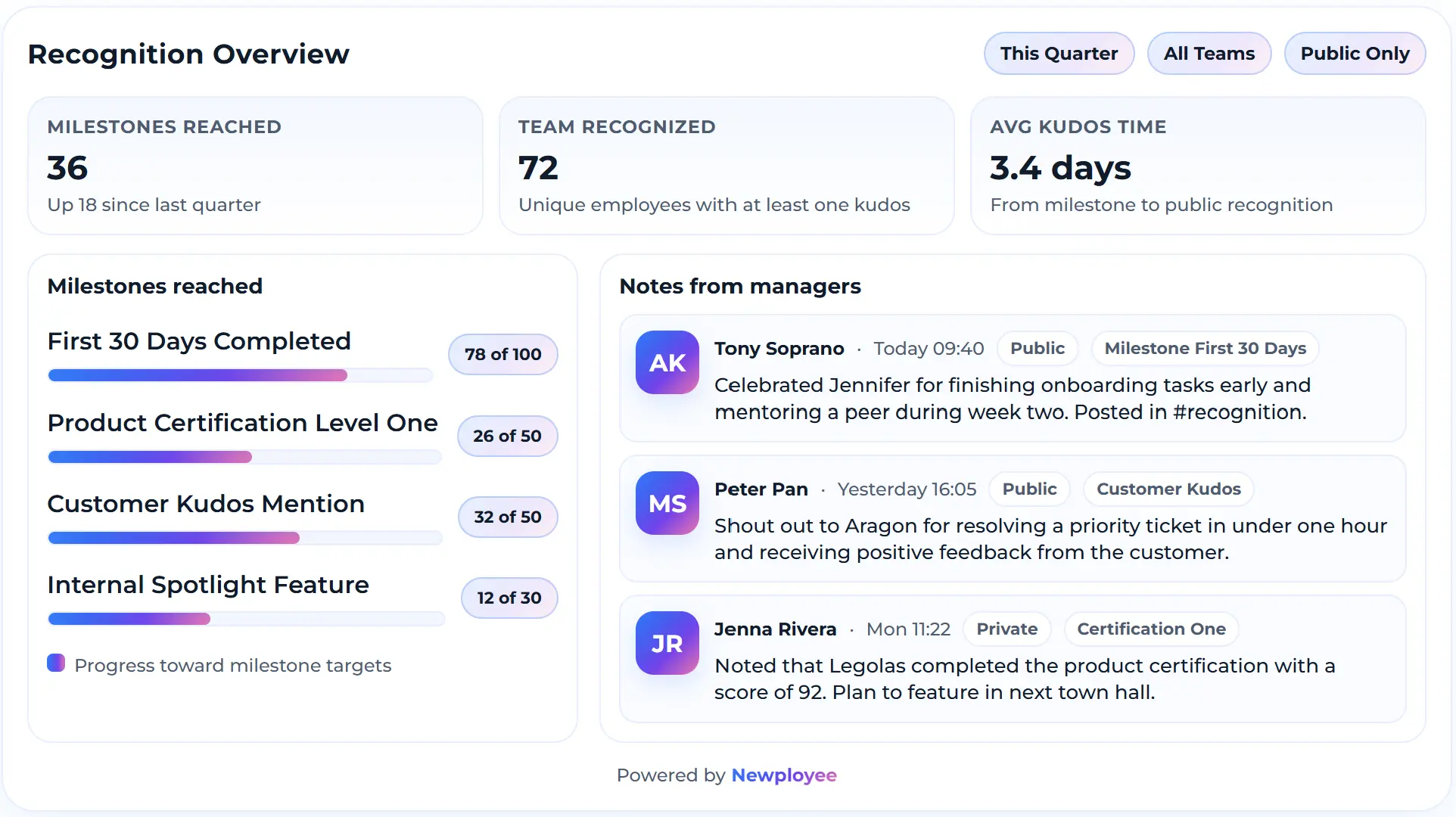
Recognition closes the loop.
It transforms onboarding from a transaction into a human experience that says
We see you.
We value you.
And we are proud of your progress.”
Sustaining Engagement Beyond Day One
Onboarding is not a checklist. It is a cultural commitment.
When companies continue nurturing new hires after the first week engagement compounds over time.
Employees who feel valued early do not just stay longer they contribute more deeply.
For HR professionals the goal is not to do more but to do better with structure automation and care working together.
Newployee makes that harmony possible by turning onboarding into a continuous journey where excitement never fades connection never stops and engagement becomes part of everyday work.
Step 6: Measure and Improve Continuously
Great onboarding is never truly finished.
It is a living system that evolves with every new hire and every lesson learned.
For HR professionals, measurement is not about micromanagement.
It is about visibility.
When you measure the right things, you can see how onboarding performs across teams, identify weak points early, and prove its business value to leadership.
Data turns onboarding from a task list into a strategic growth tool.
It shows what works, what does not, and what can be improved next time.
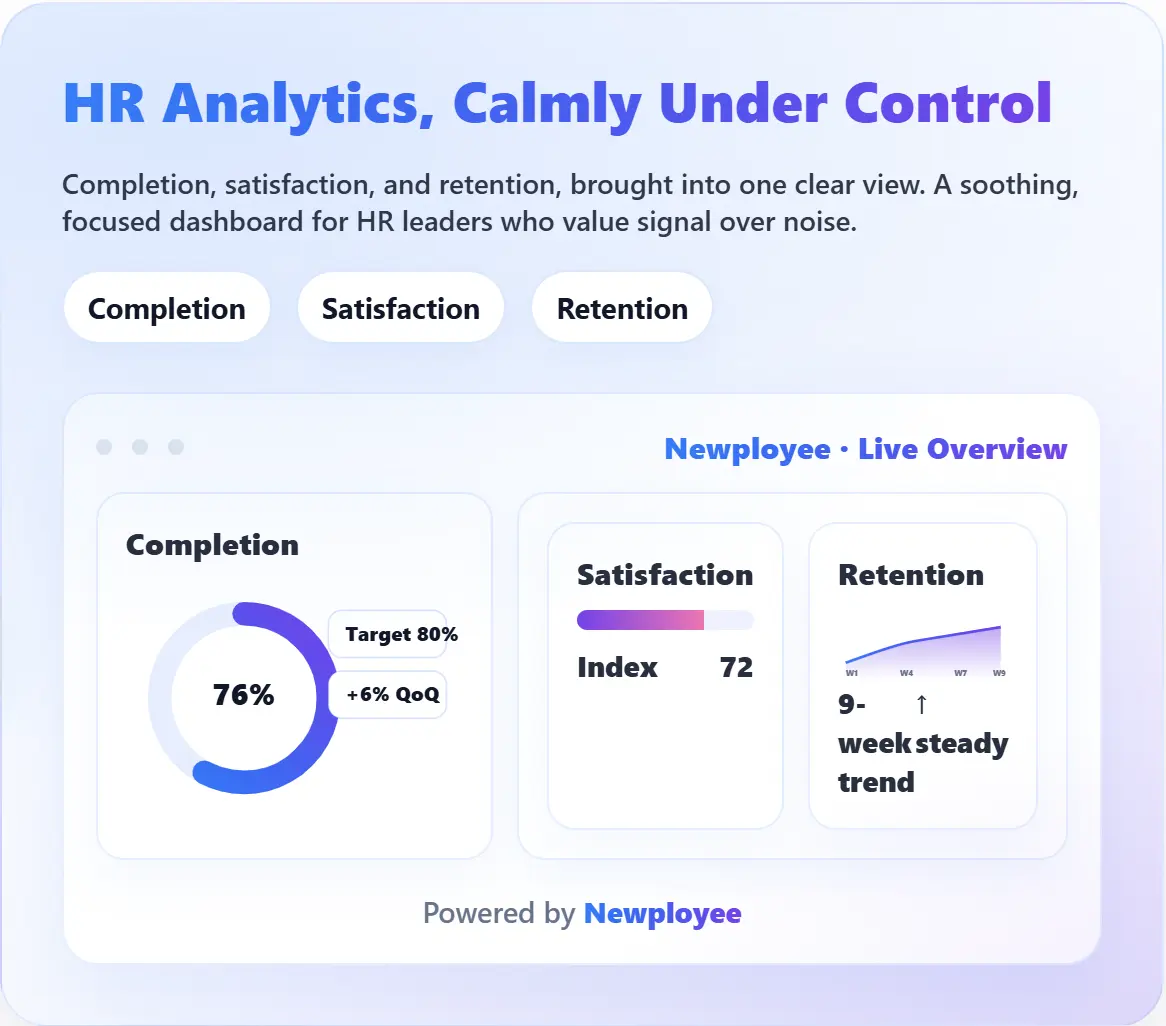
Track Onboarding Completion Rate
Completion rate is the heartbeat of your onboarding process.
It tells you whether new hires are progressing smoothly or getting stuck somewhere along the way.
Low completion means friction, unclear expectations, or missing accountability.
High completion means clarity, alignment, and support.
To understand why numbers look the way they do, track completion by department, location, and manager.
Patterns often reveal operational issues or cultural gaps.
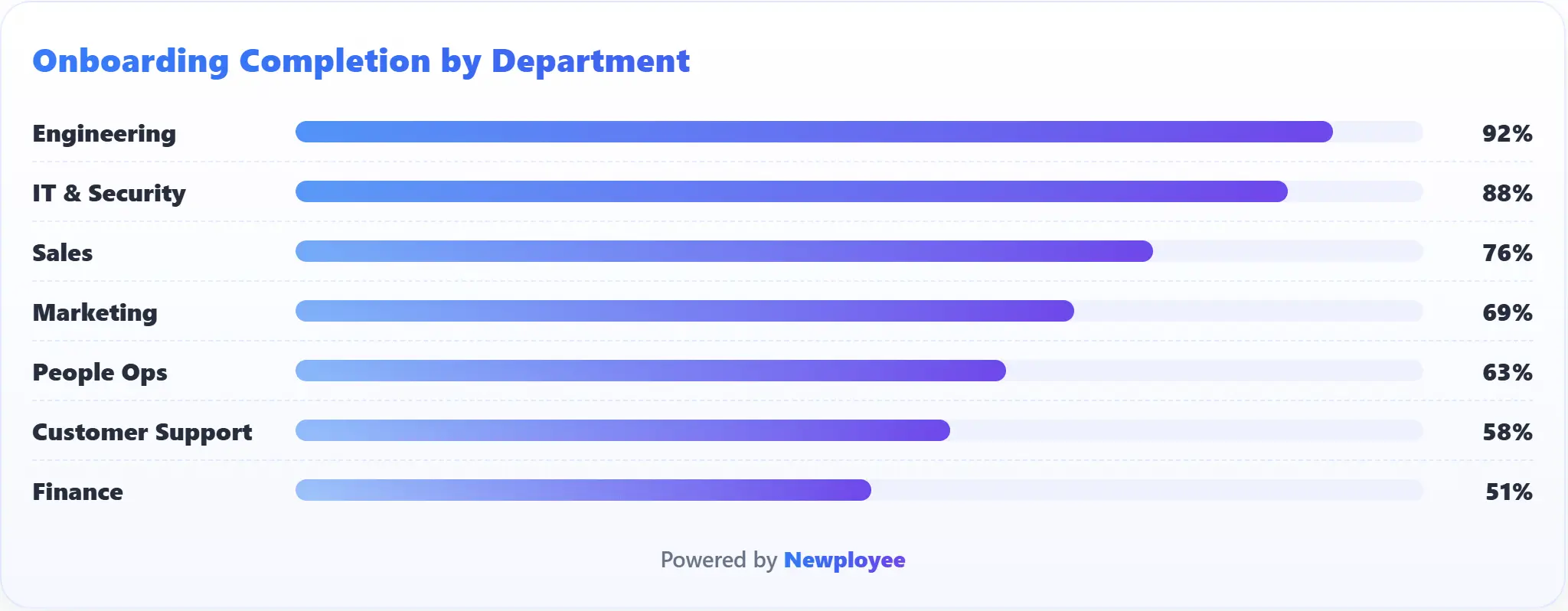
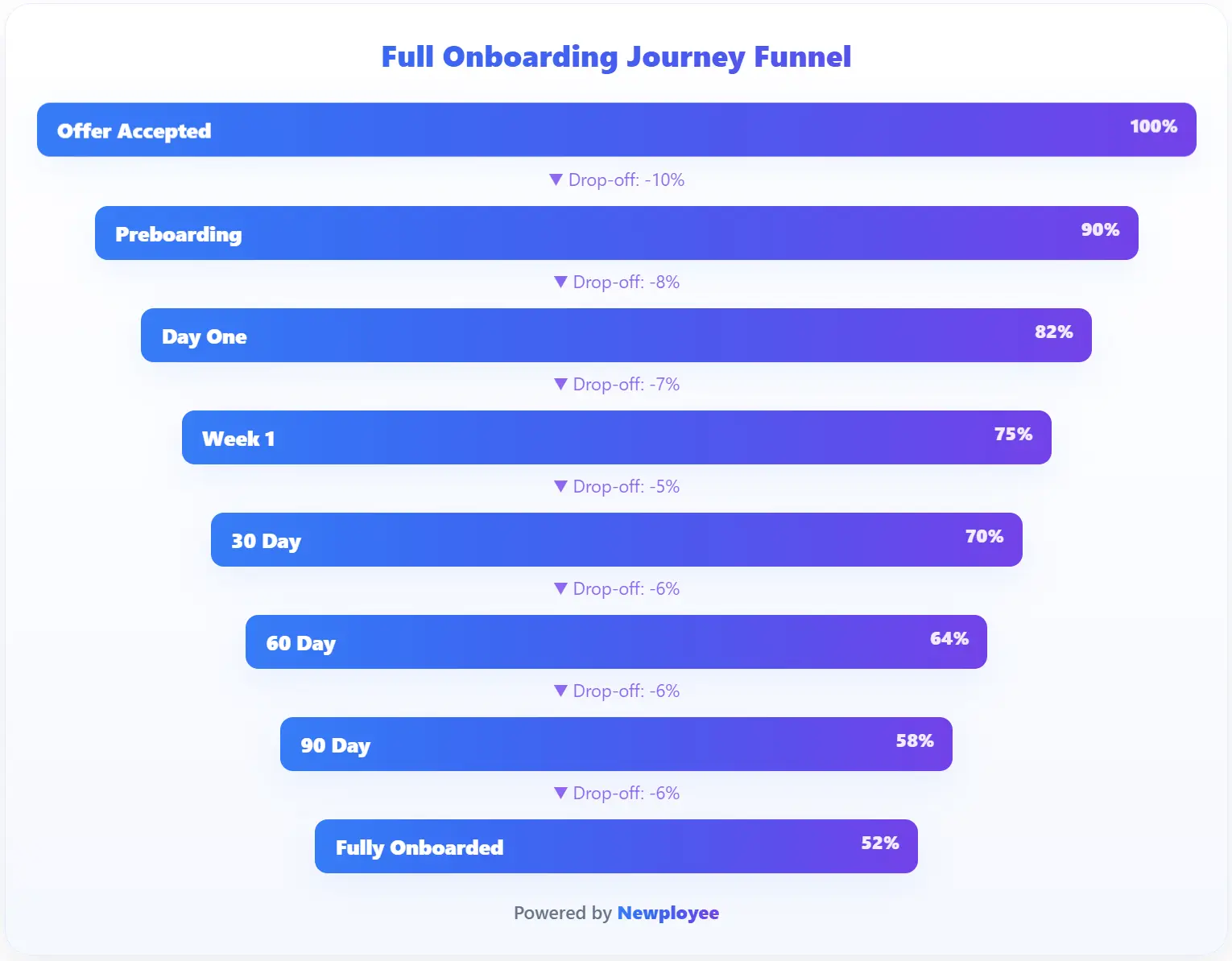
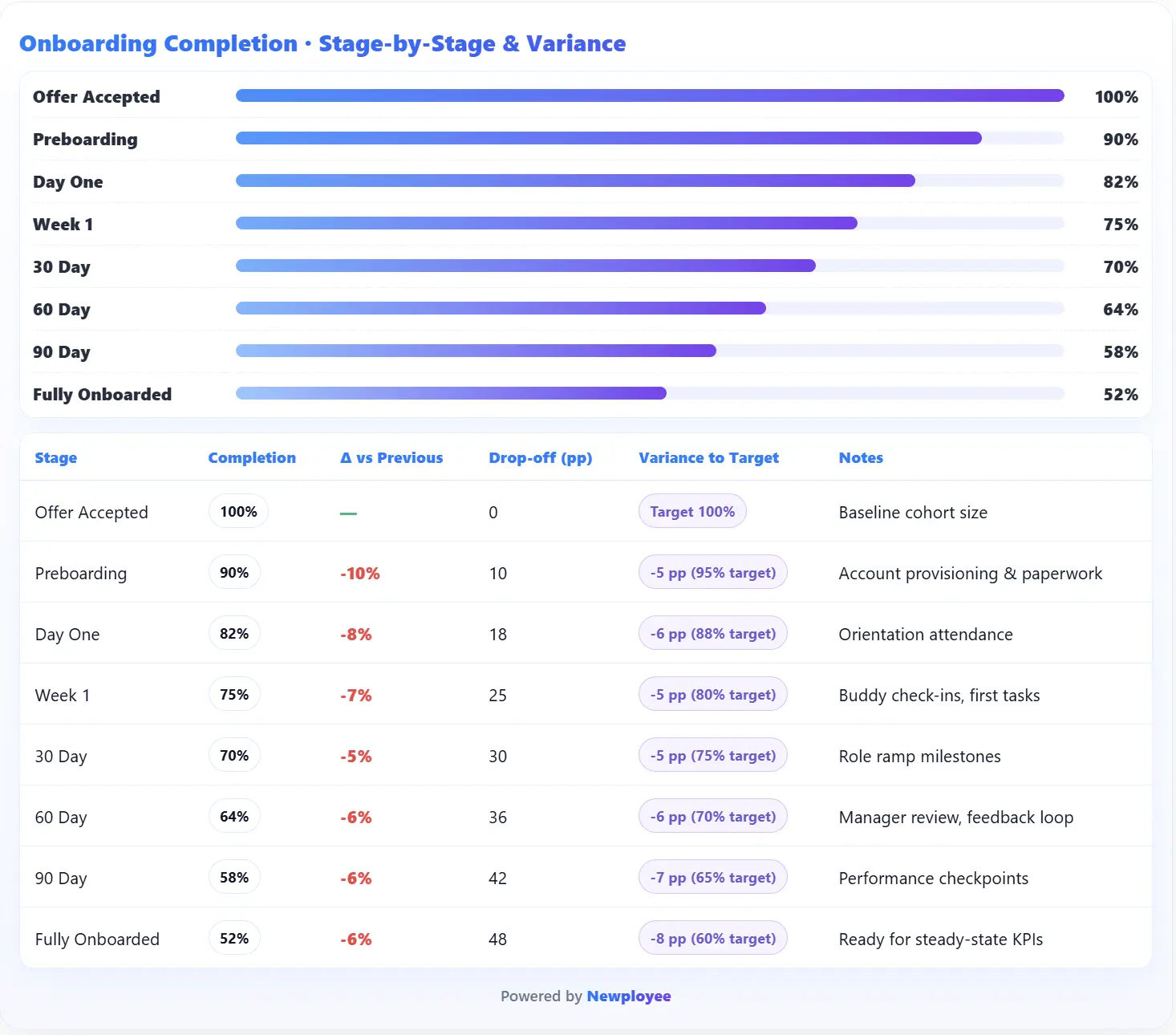
Measure Satisfaction and Retention
Completion tells you what people did.
Satisfaction tells you how they felt.
Retention tells you whether those feelings lasted.
Together, they show the true emotional and operational health of onboarding.
Ask questions such as:
- “Do you feel confident in your role?”
- “Is your workload manageable?”
- “Did onboarding prepare you to succeed?”
Collect this feedback continuously, not just at the end.
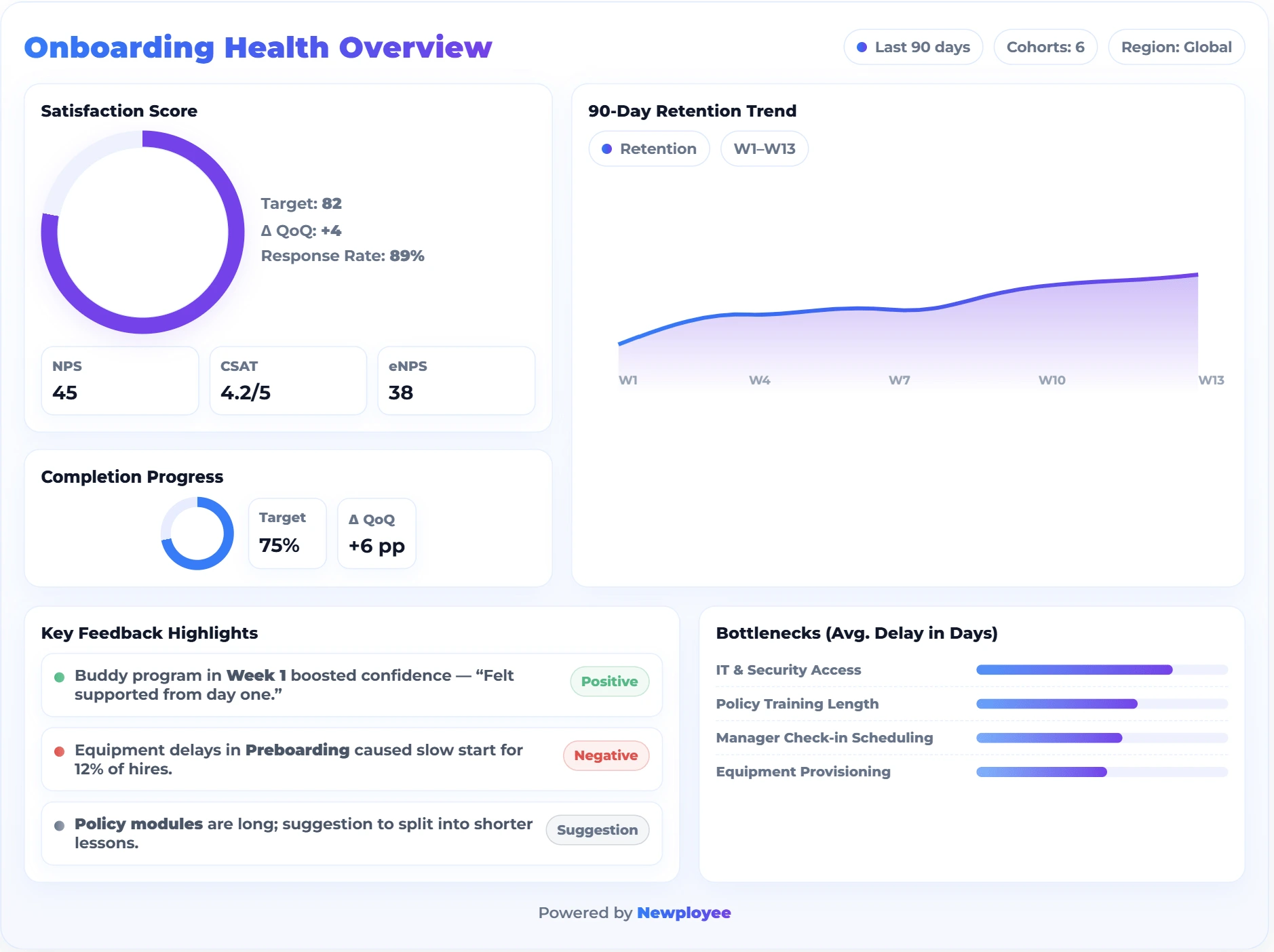
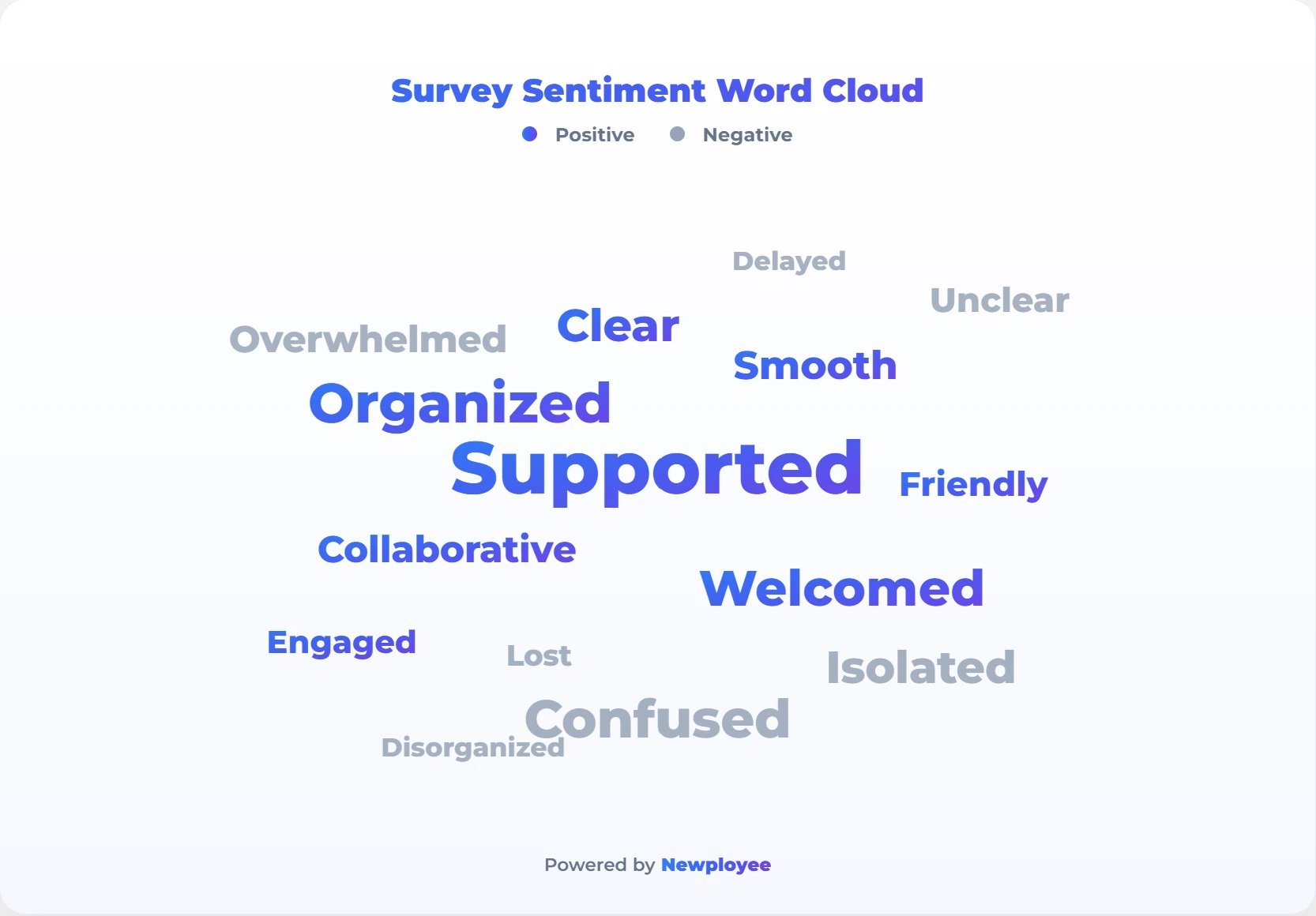
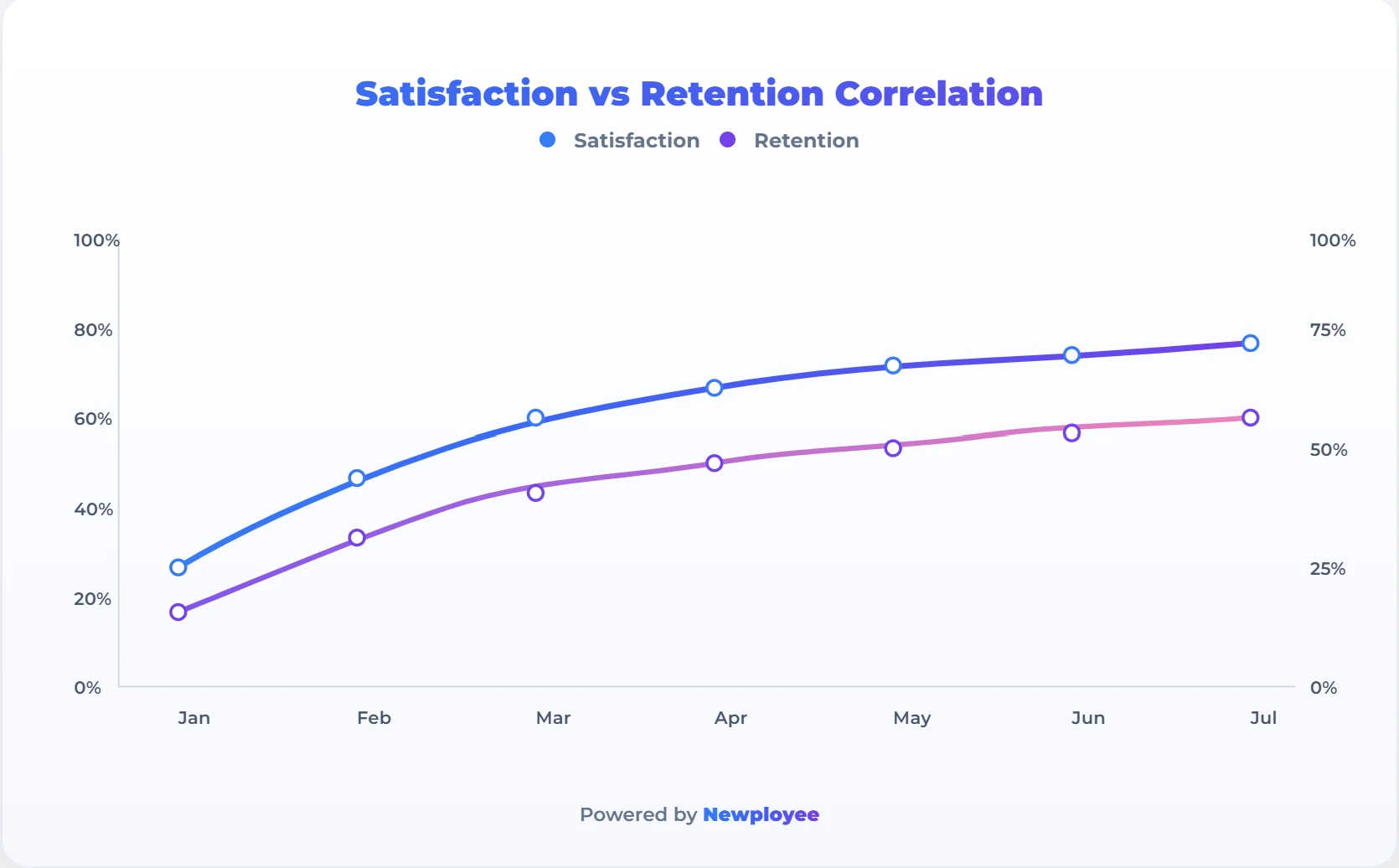
Use Data to Iterate and Improve the Process
Collecting data is the first step. Acting on it creates transformation.
After each onboarding cycle, HR should analyze outcomes and identify friction points.
Ask questions like:
- Which steps caused confusion or delay?
- Which tasks were skipped?
- Which teams showed the highest satisfaction?
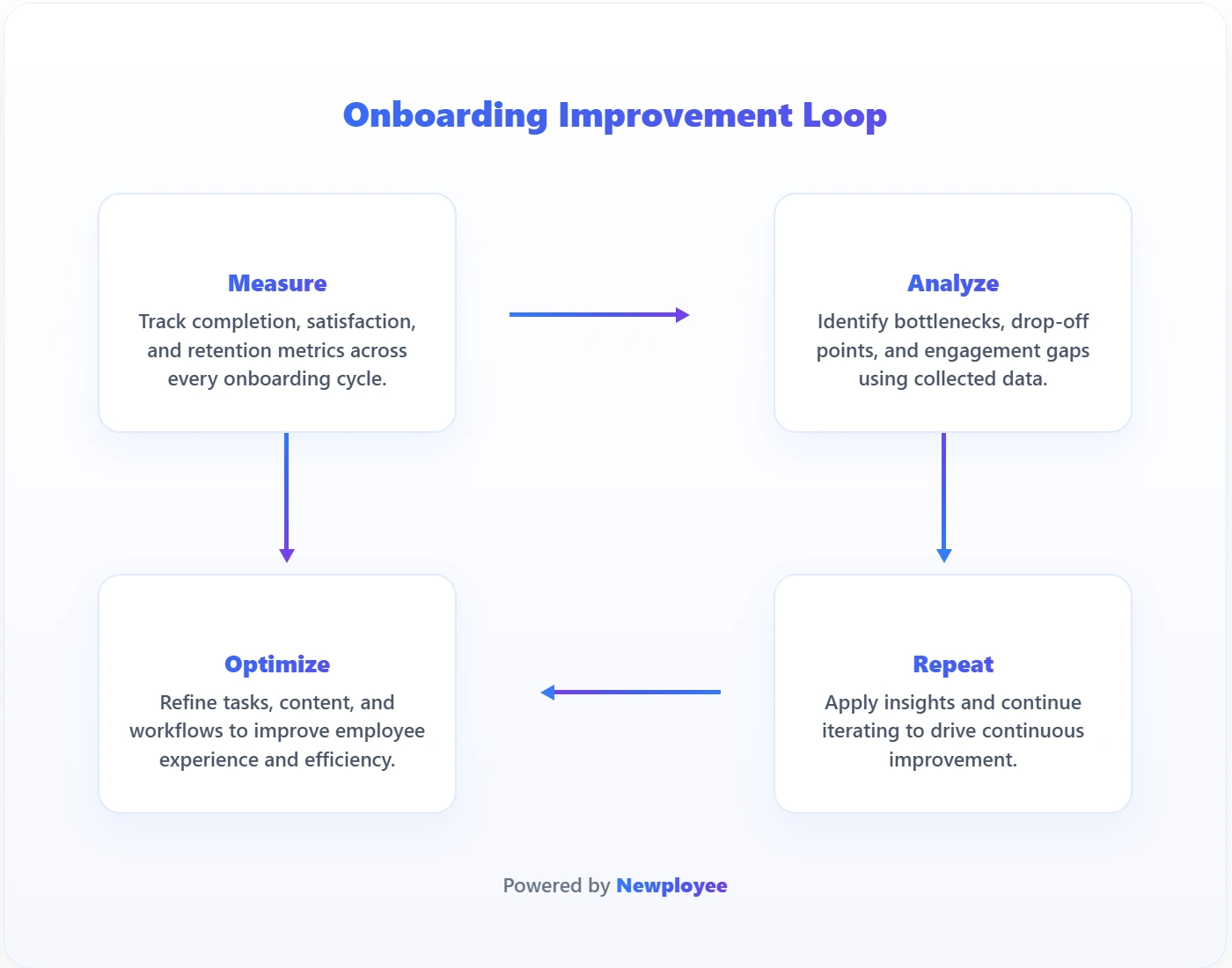
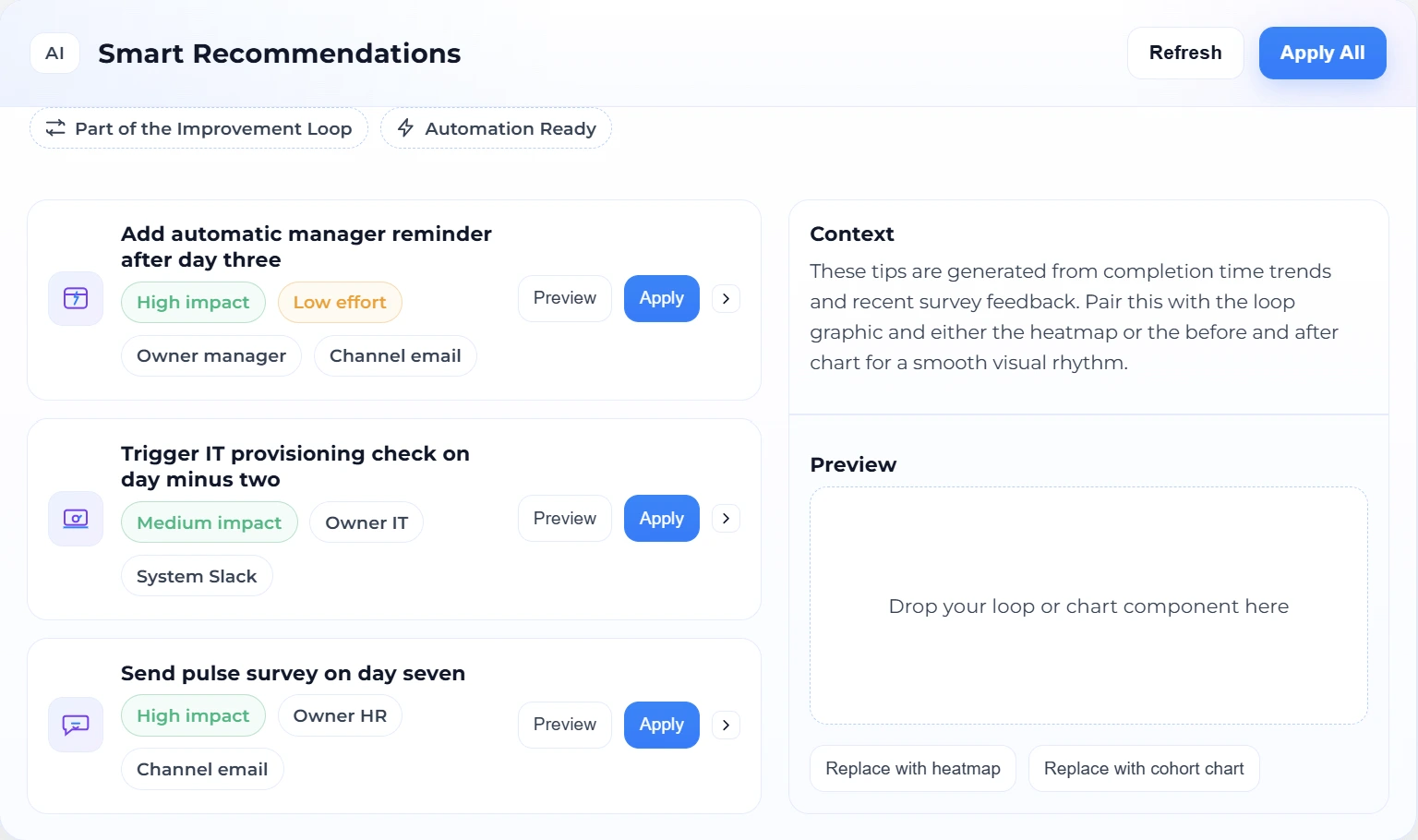
Automation turns HR from reactive to predictive.
Instead of asking “What went wrong?” data systems begin to highlight “What will go wrong next.
Turn Data into Strategic Storytelling
Data only matters when it drives action and alignment.
The best HR leaders translate metrics into meaningful stories that engage executives.
Use data to tell stories such as:
- “Reducing onboarding time by five days saved each department ten work hours.”
- “Retention improved seventeen percent after adding weekly manager check-ins.”
- “Teams using automated recognition saw satisfaction rise twenty two percent.”
The Power of Continuous Measurement
Continuous measurement does not mean collecting endless data.
It means tracking what truly matters, completion, satisfaction, and retention, and using it to build a stronger employee experience.
When you measure consistently, onboarding becomes predictable, scalable, and human-centered.
Measurement gives HR credibility.
It builds alignment between people and performance.
And it ensures that every onboarding experience is not just managed but continually refined.
Conclusion
Remote onboarding is not just a process.
It is your company’s first act of culture.
Every message every task every touchpoint tells new hires what kind of organization they have joined.
When onboarding is intentional structured and human employees feel seen supported and ready to succeed.
Newployee helps HR teams design that experience by combining empathy with precision.
It turns remote work into real connection and transforms onboarding from a checklist into culture in motion.
.webp)







